
Support our hydrofoil educational content for free when you purchase through links on our site. Learn more

[2023] Hydrofoil Yacht: The Ultimate Guide to Sailing on Foils
- November 1, 2023
- Hydrofoil Basics
Quick Answer: A hydrofoil yacht is a sailboat equipped with wing-like foils that lift the hull out of the water as it gains speed. This reduces drag, increases speed, and provides a smoother ride. Hydrofoil yachts can be retrofitted on both monohull and multihull sailboats, with different types of foils used for stability and control.
Welcome to Hydrofoiling™, where we bring you all the latest and greatest information about hydrofoil boarding. In this comprehensive guide, we’ll dive into the world of hydrofoil yachts, exploring their history, configurations, classes, and more. Whether you’re a seasoned sailor or a curious beginner, this article will provide you with expert advice and insights into the exciting world of hydrofoil yachts.
Table of Contents
Quick answer, quick tips and facts, background: the evolution of hydrofoil yachts, types of hydrofoil yachts, hydrofoil classes: from moths to ac75, hydrofoil yacht brands and models, advantages and disadvantages of hydrofoil yachts.
- Recommended Links
- Reference Links
A hydrofoil yacht is a sailboat equipped with wing-like foils that lift the hull out of the water as it gains speed. This lifting action reduces the wetted area of the hull, minimizing drag and allowing the yacht to achieve higher speeds. Hydrofoil yachts can be retrofitted on both monohull and multihull sailboats, with different types of foils used for stability and control.
Shopping Links: Check out hydrofoil yacht products on Amazon | Shop hydrofoil yacht on Walmart | Etsy hydrofoil yacht products
- Hydrofoil yachts use foils to lift the hull out of the water, reducing drag and increasing speed.
- Different types of foils, such as T foils, C foils, S foils, and L foils, are used for stability and control.
- Hydrofoil yachts can be retrofitted on both monohull and multihull sailboats.
- The International Moth class is one of the most widespread uses of hydrofoils in sailboats.
- Hydrofoil yachts can achieve impressive speeds, with some reaching over 50 knots.
Hydrofoil technology has been around for over a century, with the first patent for a hydrofoil boat filed in 1898 by Italian engineer Enrico Forlanini. Since then, hydrofoil yachts have undergone significant advancements, transforming the sailing experience and pushing the boundaries of speed and performance.
The concept behind hydrofoil yachts is simple yet ingenious. By using wing-like foils mounted under the hull, these yachts can lift themselves out of the water as they gain speed. This lifting action reduces the wetted area of the hull, minimizing drag and allowing the yacht to glide effortlessly through the water.
Hydrofoil yachts come in various configurations, each designed to optimize performance and stability. Let’s explore some of the most common types of hydrofoil yachts:
Monohull Hydrofoil Yachts : Monohull hydrofoil yachts feature a single hull and employ a “ladder” arrangement of hydrofoils. These hydrofoils typically have a dihedral angle of around 50 degrees and are complemented by a stabilizing rudder foil. This configuration provides stability and control, allowing the yacht to sail smoothly on foils.
Multihull Hydrofoil Yachts : Multihull hydrofoil yachts, such as catamarans and trimarans, offer increased stability and performance. These yachts use wider planforms, allowing for greater lift and control. Some multihulls utilize three foils, with two main forward foils providing lift and a horizontal foil on the rudder for additional control.
Hydrofoil Catamarans : Hydrofoil catamarans, also known as foilcats, combine the stability of a catamaran with the speed and efficiency of hydrofoils. These yachts can achieve impressive speeds while maintaining excellent stability, making them popular choices for racing and recreational sailing.
Hydrofoil technology has found its way into various sailing classes, revolutionizing the way we sail. Let’s take a closer look at some of the notable hydrofoil classes:
International Moth : The International Moth class is one of the most widespread uses of hydrofoils in sailboats. These single-handed dinghies feature foiling capabilities, allowing sailors to achieve incredible speeds and maneuverability. The class has seen rapid growth since 2001, with carbon fiber foils and advanced design techniques pushing the boundaries of performance.
Waszp : The Waszp class is similar to the International Moth class but utilizes aluminum foils instead of carbon fiber. This makes the Waszp more accessible to a wider range of sailors while still providing the exhilaration of foiling.
AC75 : The AC75 is a foiling monohull sailboat class used in the 2021 America’s Cup. These impressive yachts can reach speeds of up to 50 knots, showcasing the incredible potential of hydrofoil technology in the world of competitive sailing.
IQFoil : The IQFoil windsurfer class was selected by World Sailing for the 2024 Summer Olympics. These windsurfers feature hydrofoils, allowing athletes to glide above the water and achieve impressive speeds.
IMOCA 60 : Originally designed as non-foiling offshore racers, the IMOCA 60 class has embraced hydrofoil technology. These yachts now feature S-shaped daggerboard foils, providing partial foiling capabilities and enhancing performance in various conditions.
F50 : The F50 sailboat class is used in the SailGP series and is the first sailboat class to break the 50-knot barrier during a race, with a top speed of 52.2 knots. These high-performance catamarans showcase the incredible speed and agility that hydrofoil technology can offer.
Several brands have embraced hydrofoil technology, offering a range of hydrofoil yachts to cater to different sailing preferences. Here are some notable hydrofoil yacht brands and models:
Gunboat : Gunboat is a renowned brand in the world of luxury hydrofoil yachts. Their models, such as the Gunboat 68 and Gunboat 72, combine performance, comfort, and elegance, providing an exceptional sailing experience.
GC32 : The GC32 is a hydrofoil catamaran designed for high-performance racing. This foiling catamaran offers thrilling speeds and precise control, making it a favorite among competitive sailors.
AC72 and AC45f/AC50 : These hydrofoil catamarans were used in the America’s Cup, showcasing the cutting-edge technology and innovation in the world of hydrofoil yachts. These yachts pushed the boundaries of speed and performance, captivating sailing enthusiasts worldwide.
Nacra 17 and Nacra F20 : Nacra is a well-known brand in the world of multihull sailing, and their Nacra 17 and Nacra F20 models feature hydrofoil capabilities. These yachts offer a perfect balance of speed, stability, and maneuverability, making them popular choices for recreational and competitive sailing.
Hydrofoil yachts offer a range of advantages that make them appealing to sailors seeking speed, performance, and an exhilarating sailing experience. However, they also come with some drawbacks. Let’s explore the pros and cons of hydrofoil yachts:
Advantages:
Increased Speed : Hydrofoil yachts can achieve impressive speeds, thanks to reduced drag and increased lift. This allows sailors to cover more distance in less time, making hydrofoil yachts ideal for racing or simply enjoying the thrill of speed on the water.
Smooth Ride : By lifting the hull out of the water, hydrofoil yachts provide a smoother and more comfortable sailing experience. The reduced contact with the water minimizes the impact of waves and chop, resulting in a smoother ride even in rough conditions.
Improved Efficiency : Hydrofoil yachts are more efficient than traditional sailboats, thanks to reduced drag and improved lift. This increased efficiency translates to better performance and reduced energy consumption, making hydrofoil yachts an environmentally friendly choice.
Disadvantages:
Complex Design : Hydrofoil yachts require a more complex design compared to traditional sailboats. The addition of foils and the associated control systems can increase the complexity of the yacht, requiring more maintenance and potentially higher costs.
Learning Curve : Sailing a hydrofoil yacht requires a certain level of skill and experience. The handling and control of a hydrofoil yacht can be more challenging compared to traditional sailboats, requiring sailors to adapt to the unique characteristics of foiling.
Higher Costs : Hydrofoil yachts, especially high-performance models, can come with a higher price tag compared to traditional sailboats. The advanced technology, materials, and design required for hydrofoil yachts contribute to their higher cost.
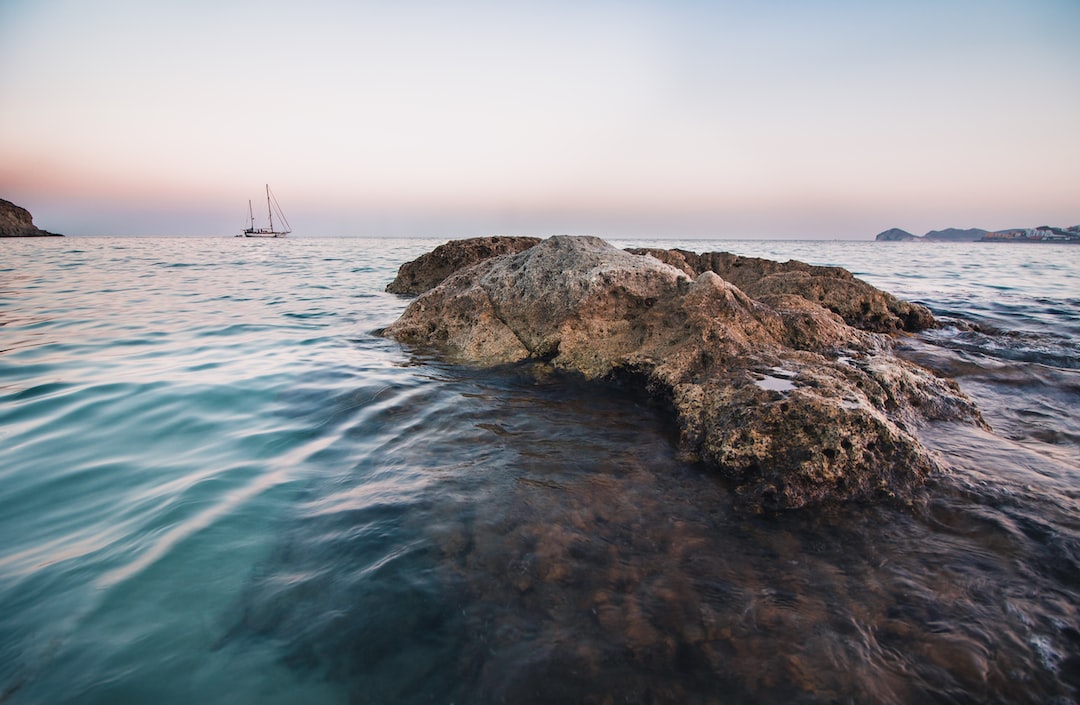
How fast is the hydrofoil racing yacht?
Hydrofoil racing yachts can achieve impressive speeds, with some models reaching over 50 knots (57.5 mph or 92.6 km/h). The F50 sailboat class, used in the SailGP series, holds the record for the fastest sailboat class, with a top speed of 52.2 knots (60 mph or 97 km/h).
What does a hydrofoil do to a boat?
A hydrofoil lifts the hull of a boat out of the water as it gains speed. This reduces the wetted area of the hull, minimizing drag and allowing the boat to achieve higher speeds. The lifting action of the hydrofoil also provides a smoother ride by reducing the impact of waves and chop.
Read more about “… Hydrofoil Catamaran: The Ultimate Guide to Foiling on Water”
How fast do hydrofoil boats go?
Hydrofoil boats can reach impressive speeds, depending on their design and purpose. Racing hydrofoil yachts can achieve speeds over 50 knots (57.5 mph or 92.6 km/h), while recreational hydrofoil boats can reach speeds of 20-30 knots (23-34.5 mph or 37-55.5 km/h) or more.
Why don’t boats use hydrofoils?
While hydrofoils offer significant advantages in terms of speed and efficiency, they also come with certain limitations. The complex design and higher costs associated with hydrofoils can be prohibitive for some boat owners. Additionally, the handling and control of hydrofoil boats require a certain level of skill and experience, making them less accessible to novice sailors.
Read more about “… Why do boats not use hydrofoils?”
Hydrofoil yachts have revolutionized the sailing experience, offering increased speed, improved efficiency, and a smoother ride. Whether you’re a competitive sailor looking for the thrill of high-speed racing or a recreational sailor seeking a more exhilarating sailing experience, hydrofoil yachts provide an exciting and innovative option.
Recommended Links:
- Hydrofoil History
- Advanced Hydrofoiling Techniques
- Hydrofoil Equipment Reviews
- How Do Hydrofoils Work on Boats? 2023
Reference Links:
- Sailing Hydrofoil – Wikipedia
- Gunboat Official Website
- Nacra Official Website
- SailGP Official Website
- America’s Cup Official Website
Now that you have a comprehensive understanding of hydrofoil yachts, it’s time to set sail and experience the thrill of foiling firsthand. Whether you’re racing on the high seas or cruising along the coast, a hydrofoil yacht will take your sailing adventures to new heights. Happy foiling!
Disclaimer: The information provided in this article is based on research and personal experience. Hydrofoiling™ is not affiliated with any specific brand or product mentioned in this article. Always consult with experts and follow safety guidelines when engaging in hydrofoil activities.
Review Team
The Popular Brands Review Team is a collective of seasoned professionals boasting an extensive and varied portfolio in the field of product evaluation. Composed of experts with specialties across a myriad of industries, the team’s collective experience spans across numerous decades, allowing them a unique depth and breadth of understanding when it comes to reviewing different brands and products.
Leaders in their respective fields, the team's expertise ranges from technology and electronics to fashion, luxury goods, outdoor and sports equipment, and even food and beverages. Their years of dedication and acute understanding of their sectors have given them an uncanny ability to discern the most subtle nuances of product design, functionality, and overall quality.
Related Posts
Can you put a hydrofoil on any board [2024] 🏄♂️.
- March 13, 2024
Is Hydrofoil Harder Than Surfing? [2024] 🏄♂️
- March 3, 2024
Are Hydrofoil Boards Hard to Ride? [2024] 🏄♂️
Leave a reply cancel reply.
Your email address will not be published. Required fields are marked *
Add Comment *
Save my name, email, and website in this browser for the next time I comment.
Post Comment
Trending now
How SailGP’s foiling F50 catamarans sail so much faster than the wind

Arguably the most technologically advanced sailboats on the planet right now, the one-design SailGP F50 foiling catamarans are capable of breathtaking speeds – at times, reaching four times the velocity of the wind that drives them. But how do they do it?
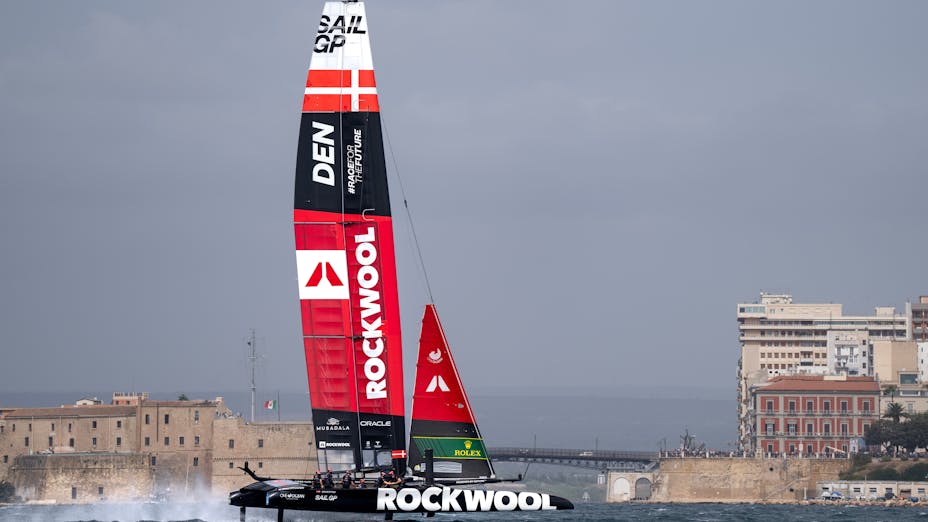
Beating the balloon

Bending the laws of physics

Faster and faster

Beneath The Surface
Watch on youtube.
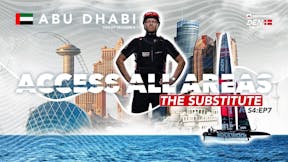
Access All Areas
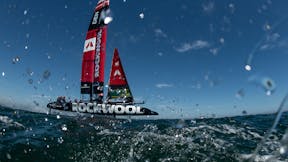
Want to learn more about SailGP?
Meet the denmark sailgp team, find all the latest news, go beneath the surface of sailgp, sailing terms, go beneath the surface.
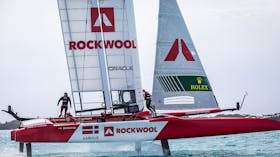
How the world’s fastest sail racing boats fly above the water

The Beneath The Surface show

This is how SailGP's NASA-inspired wings make the F50 boats fly

ROCKWOOL Denmark SailGP Team

ROCKWOOL Group
Foil Sailboat: The Ultimate Guide to High-Speed Sailing
by Emma Sullivan | Jul 15, 2023 | Sailboat Maintenance
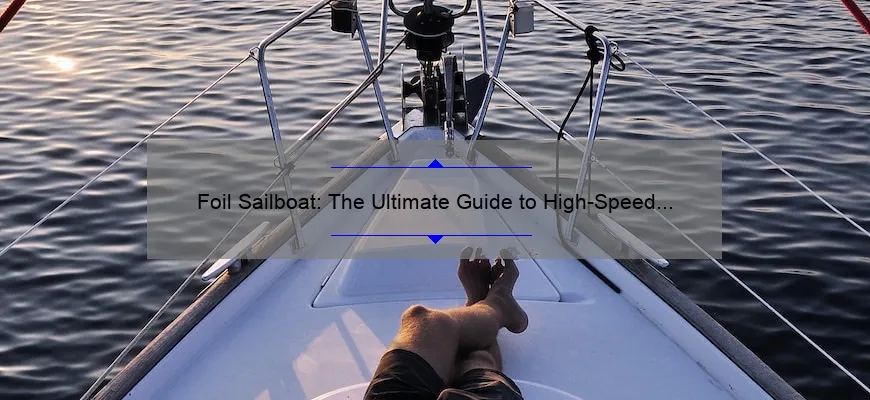
Short answer: Foil sailboat
A foil sailboat is a type of sailing vessel equipped with hydrofoils, which are wing-like structures submerged below the water’s surface. These foils generate lift as the boat gains speed, enabling it to rise above the water and reduce drag, resulting in increased speed and efficiency.
What is a Foil Sailboat? Exploring the Basics of this Innovative Watercraft
When it comes to sailing, innovation is always at the forefront of enthusiasts’ minds. One of the latest developments in the world of boating is the foil sailboat. These cutting-edge watercraft have become increasingly popular for their ability to elevate the sailing experience to new heights—both literally and figuratively.
So, what exactly is a foil sailboat? At its core, a foil sailboat is a vessel equipped with hydrofoils. Hydrofoils are wing-like structures that extend below the hull of the boat and provide lift as they move through the water. This lift then allows the boat to rise above the surface, reducing drag and increasing speed—an absolute game-changer for avid sailors looking to maximize their sail’s potential.
The innovative aspect of these boats lies in this newfound ability to effortlessly glide above choppy waters. Traditional sailboats often encounter resistance from waves, which can slow them down considerably. However, with hydrofoils, a foil sailboat can expertly navigate over rough seas, without sacrificing its speed or performance.
Imagine effortlessly skimming across the water’s surface like a seabird gliding through air currents—that’s precisely what it feels like on a foil sailboat! The exhilaration and sense of freedom that come with this type of sailing experience cannot be described adequately; it must be personally witnessed and felt.
Foil sailboats also offer an added element of safety compared to traditional sailing vessels. As they ride above water, there is less chance of collision with submerged obstacles or marine life—a comforting thought for anyone who has ever worried about hitting unexpected debris while out at sea.
Additionally, these boats boast exceptional maneuverability due to their foils’ adjustability. Sailors can control how far below or above the surface these wings extend, allowing for precise navigation in any situation. Whether you’re facing strong winds or meandering through tight channels, precise control over your vessel becomes second nature on a foil sailboat.
It’s worth noting that while foil sailboats may seem like something out of a science fiction novel, they are accessible to both experienced and novice sailors. Admittedly, mastering the art of sailing on these boats does require some skill and practice, but once you get the hang of it, there’s no turning back.
In conclusion, foil sailboats have revolutionized the way we navigate the seas. By harnessing the power of hydrofoils, these vessels can cruise above choppy waters effortlessly and gracefully. They offer unparalleled speed, maneuverability, and safety—an exciting proposition for any sailing enthusiast looking to elevate their craft to new heights.
So why not set sail on a foil sailboat? Experience the thrill of skimming across the water with winds in your sails and excitement in your heart. Embark on an adventure that combines innovation with tradition and embrace the future of sailing—a world where foiling is not just a dream but a reality!
How to Build a Foil Sailboat: A Step-by-Step Guide for Beginners
Title: How to Build a Foil Sailboat: A Step-by-Step Guide for Beginners
Introduction: Building your own foil sailboat can be an exciting and rewarding project, allowing you to experience the thrill of sailing on water while showcasing your DIY skills. Whether you’re a seasoned boat builder or a beginner eager to take on a new challenge, this step-by-step guide will walk you through the process with detailed instructions, professional tips, and a touch of wit and cleverness along the way. So grab your tools and let’s embark on an adventure in boat building!
1. Choosing the Right Design: Before diving into construction, it’s important to select a suitable design for your foil sailboat. Consider factors such as usability, stability, speed potential, materials required, and learning curve involved. We’ll discuss various designs ranging from simple dinghies to more complex foiling yachts, highlighting their pros and cons in detail.
2. Gathering Materials: Once you have selected a design that suits your needs and aspirations as a sailor, it’s time to gather the necessary materials. From marine-grade plywood and epoxy resin to stainless steel fittings and reinforcements like carbon fiber or fiberglass cloth – we’ll provide comprehensive guidance on acquiring everything needed for constructing your dream vessel.
3. Crafting the Hull: The hull is undoubtedly the most significant part of any sailboat construction project. We’ll delve deep into shaping different sections of the hull using traditional wooden boatbuilding techniques or modern foam-isolation methods – laying out detailed steps accompanied by helpful illustrations that showcase each stage impeccably.
4. Installation of Foils: Now comes the exciting part – installing foils! This critical step determines how well your sailboat will maneuver through water while providing stability during sailing sessions. We’ll guide you through attaching daggerboards or centerboards securely, ensuring proper balance between lifting force and efficiency while explaining how different foil shapes influence performance.
5. Assembling Rigging and Sails: A sailboat is incomplete without a properly rigged mast, boom, and sails. We’ll walk you through the process of rigging your foil sailboat, discussing essential components such as shrouds, halyards, and blocks. In addition to ensuring a solid construction, we’ll present clever tips for optimizing sail shape, maximizing efficiency, and minimizing turbulence – secrets that only seasoned sailors usually come across!
6. Fine-tuning the Details: Building a foil sailboat demands meticulous attention to detail. From sanding and painting the hull to applying finishing touches like varnish or marine-grade paint; this step-by-step guide will cover all aspects of refining your boat’s appearance while safeguarding its longevity against harsh sea conditions.
7. Launch Day Excitement: After long hours of hard work and dedication, it’s finally time to launch your newly built foil sailboat into the water! We’ll provide practical advice on testing your creation for stability before taking that first exhilarating voyage. Tips on handling common challenges faced by beginners will be discussed with witty anecdotes from experienced sailors who’ve been in the same boat – pun intended.
Conclusion: Building a foil sailboat may seem daunting at first glance, but armed with passion, patience, and our detailed step-by-step guide for beginners; you’ll find yourself sailing through the project with confidence. As you construct each section with precision and care – bring out your inner DIY enthusiast while embracing professional techniques shared throughout this witty and clever manual. So set sail on this adventure of building dreams one plank at a time – happy boat building!
Unleashing the Power of Wind and Water: Why Choose a Foil Sailboat
Are you looking to take your sailing experience to new heights? Do you yearn for the thrill of effortlessly gliding through the water, harnessing the forces of wind and waves? If so, then it’s time to consider upgrading to a foil sailboat. With its innovative design and cutting-edge technology, a foil sailboat opens up a whole new world of possibilities for both seasoned sailors and those just starting out.
So, what exactly is a foil sailboat, you may ask? Well, at its core, it’s still a traditional sailboat equipped with sails that catch the wind. However, what sets it apart is the addition of hydrofoils – thin wings that extend below the hull – which revolutionize its performance on water. These foils are designed to lift the entire boat out of the water once a certain speed is reached, thereby reducing drag and allowing for incredible speeds.
One of the most captivating aspects of foil sailboats is their ability to literally fly above the surface. As they lift off from the water thanks to their hydrofoils, sailors are treated to an exhilarating sensation akin to soaring in mid-air while savoring breathtaking views. It’s like having your own personal flying carpet!
But why choose a foil sailboat over traditional sailing vessels? Three words: speed, efficiency, and control.
With their reduced drag, these boats can achieve unprecedented speeds that leave other boats in their wake. The lift generated by hydrofoils eliminates much of the resistance caused by friction between hull and water. This allows sleeker designs capable of carving through waves like hot knives through butter.
Not only do foil sailboats maximize speed potential; they also enhance fuel efficiency like never before. By greatly reducing contact with water during operation due to foiling capabilities, these vessels require significantly less propulsion power when compared to standard sailboats. This means you can enjoy longer journeys, explore more remote areas, and reach your destinations faster while spending less on fuel.
In the realm of control, foil sailboats present a game-changing advantage. The controlled motion created by hydrofoils allows for exceptional stability and reduced heeling (the leaning of a boat caused by wind). This significantly improves safety and comfort during sailing, making it an ideal choice for those prone to seasickness or looking for a smoother ride.
Equally important is the environmental aspect. By opting for a foil sailboat, you are actively contributing to a greener future. Less reliance on traditional propulsion systems means fewer emissions and minimal impact on marine ecosystems. Harnessing the power of wind and water in such an efficient manner, this modern marvel represents the evolution towards sustainable navigation.
So whether you are an adrenaline junkie thirsty for speed, an eco-conscious sailor seeking to minimize your carbon footprint, or someone who simply wants to elevate their sailing experience to new heights, choosing a foil sailboat is undoubtedly the right decision. Unleash the power of wind and water like never before – embark on an incredible adventure that defies gravity with these magnificent vessels!
Frequently Asked Questions about Foil Sailboats: All You Need to Know
Foil sailboats have been making waves in the sailing world, quite literally! These innovative watercraft have gained immense popularity among sailing enthusiasts for their remarkable speed and agility on the water. However, with this rise in popularity comes a plethora of questions from curious individuals eager to unravel the mysteries surrounding foil sailboats. In this blog post, we will delve deep into the frequently asked questions about foil sailboats and provide you with all the information you need to know.
1. What is a foil sailboat? A foil sailboat is a type of watercraft that utilizes hydrofoils – wing-like structures mounted underneath the hull – to lift the boat out of the water as it sails. By reducing drag and increasing lift through these foils, these boats can achieve incredible speeds and maneuverability.
2. How do foil sailboats stay stable? Despite their futuristic appearance and ability to seemingly defy gravity, foil sailboats maintain stability through careful design and balance. The positioning of the foils, along with adjustments made by skilled sailors, counteract any tendency for capsizing or loss of control.
3. Are foil sailboats only suitable for professional sailors? While foil sailboats may appear intimidating at first glance, they are not reserved exclusively for seasoned pros. Manufacturers have introduced more user-friendly models that cater to beginners or intermediate sailors looking to explore this exciting realm. With proper training and experience, anyone with a passion for sailing can enjoy these exhilarating vessels.
4. Are there different types of foiling systems? Indeed! Foil sailboats can incorporate various types of foiling systems based on design preferences and intended use. The three main categories include surface-piercing foils (where only part of the surface area remains submerged), fully submerged foils (which operate entirely below the water’s surface), and T-foils (utilizing two wings forming a ‘T’ shape). Each system offers unique advantages depending on factors like speed, stability, and wind conditions.
5. Do foil sailboats have any downsides? As with any technological advancement, there are some drawbacks to foil sailboats. One primary concern is the cost, as these cutting-edge vessels often come with a hefty price tag. Maintenance and repairs may also require specialized knowledge or professional assistance. Additionally, navigating shallow waters or crowded marinas can pose challenges due to the deeper draft of the hydrofoils.
6. Are foil sailboats eco-friendly? In many ways, yes! Foil sailboats are at the forefront of sustainable sailing technology due to their ability to reduce fuel consumption by harnessing wind power more efficiently. By gliding above the water surface, these boats create minimal drag and alleviate harm to marine ecosystems caused by propellers or hulls disturbing sediment and natural habitats.
7. Can foil sailboats be raced competitively? Absolutely! In recent years, foiling has revolutionized competitive sailing. The America’s Cup, one of the most prestigious races in yachting history, introduced foiling catamarans that mesmerized audiences worldwide with their breathtaking speeds and thrilling maneuvers. Foil-enabled boats now dominate various regattas globally, bringing a new dimension of excitement to the sport.
Foil sailboats represent an exciting evolution in sailing technology that has captured sailors’ imaginations across the globe. As this burgeoning industry continues to advance and evolve further, it presents endless possibilities for both recreational sailors and competitive racers alike. So why not dip your toes into the world of foil sailboats? Prepare for an experience like no other – where exhilaration meets innovation on the open waters!
Mastering the Art of Sailing with Foils: Tips and Tricks for a Smooth Ride
Sailing with foils can be an exhilarating experience, but it also requires a certain level of skill and technique to master. Whether you’re a beginner curious about this exciting form of sailing or an experienced sailor looking to improve your foiling skills, we’ve got you covered. In this blog post, we will delve into the art of sailing with foils and provide you with some essential tips and tricks for a smooth ride on the water.
First and foremost, let’s discuss what exactly foiling is. Foiling refers to using hydrofoils – wings or fins that extend below the hull of a boat – to lift the vessel out of the water as it gains speed. This creates a sensation of gliding on air rather than sailing through water, giving you a whole new level of excitement and speed.
Now that we understand the basics, let’s dive into our tips and tricks for mastering the art of sailing with foils:
1. Choose the right equipment: Selecting suitable equipment is crucial for a successful foiling experience. Make sure your boat is specifically designed for foiling, as it requires specific engineering to handle the increased speeds and reduced drag associated with flying above water. Consider factors such as hull design, sail plan, and foil configuration when choosing your vessel.
2. Understand wind conditions: Sailing with foils heavily relies on wind conditions to generate lift and maintain stability. Familiarize yourself with weather patterns in your area and learn how different wind strengths affect foil performance. Be mindful that stronger winds may require adjustments in sail trim or foil angle to optimize control.
3. Learn proper weight distribution: Maintaining proper weight distribution between yourself as the sailor and your boat is crucial for stability during foiling. Shift your bodyweight forward when accelerating or climbing uphill on waves, while at high speeds try to keep your weight centered over the board to prevent nose diving or losing control.
4. Develop solid core strength: Foiling demands exceptional core strength and stability. Regularly incorporate exercises into your training routine that target your abdominals, obliques, and lower back to enhance your ability to maintain balance while flying above the water.
5. Practice in calm conditions: When starting out with foiling, it’s best to practice in calm conditions with minimal waves or chop. This allows you to focus on learning the feel of the foil beneath you without being overwhelmed by external factors. As you become more comfortable, gradually introduce more challenging conditions to further hone your skills.
6. Maintain a steady speed: Sailing with foils is all about finding that sweet spot of maintaining a steady speed where lift is maximized and control is optimized. Too little speed can cause loss of lift and instability, while excessive speed can lead to uncontrollable movements or even crashing. Experiment with different sail settings and foil angles until you find the ideal combination for a smooth ride.
7. Embrace continuous learning: Foiling is a dynamic discipline where constant learning and adaptation are key to success. Joining local sailing clubs or taking lessons from experienced foilers can provide invaluable insights, techniques, and feedback to improve your skills exponentially.
Remember that mastering the art of sailing with foils takes time and practice – don’t be discouraged if progress feels slow at first. Embrace each outing as an opportunity to refine your technique, build confidence, and experience the pure joy of gliding effortlessly above the water’s surface.
So get out there, embrace the thrill of flying on foils, and let these tips guide you towards becoming a skilled foiler! Happy sailing!
Taking Your Sailing Adventure to New Heights: Advantages of Using a Foil Sailboat
Are you ready to elevate your sailing experience and embark on a thrilling adventure like never before? Look no further than a foil sailboat! This revolutionary vessel has been taking the sailing world by storm, offering exciting advantages that will leave you in awe. So buckle up, tighten those sails, and get ready to explore the limitless possibilities of using a foil sailboat.
To truly grasp the marvel of a foil sailboat, let’s start with the basics. Unlike traditional sailboats, which rely solely on their hulls for buoyancy, foil sailboats incorporate hydrofoils – underwater wings that lift the boat out of the water as it gains speed. This ingenious design allows sailors to reach mind-boggling speeds and experience smoother rides even under challenging conditions.
One of the most significant advantages of using a foil sailboat is its unmatched speed potential. As these vessels rise above the water’s surface on hydrofoils, resistance decreases dramatically, allowing them to effortlessly glide through waves at incredible velocities. Whether you’re an adrenaline junkie seeking thrilling races or simply wish to shorten your travel time while enjoying the open sea, a foil sailboat has got your back!
But it doesn’t stop there – prepare yourself for an unparalleled sense of freedom as you cruise through the water aboard this cutting-edge vessel. Foil sailboats offer enhanced maneuverability due to reduced drag and increased stability provided by the hydrofoils. You’ll have precise control over every inch of your journey, easily gliding around turns and effortlessly changing course when needed. It’s like dancing with nature itself!
Imagine sailing without constantly battling against choppy waters or being disturbed by waves crashing against your boat’s hull; sounds dreamy, doesn’t it? Well, with a foil sailboat, it becomes reality! The unique lifting capabilities of hydrofoils minimize contact between your boat and rough waters, resulting in incredibly smooth rides even amidst swelling tides or turbulent seas. Breathe in the salty air, feel the wind in your hair, and revel in the serenity of a sailing experience elevated to new heights.
Safety is always a top priority when it comes to any adventure sport – and foil sailboats excel in this aspect as well. Thanks to their ability to elevate above water level, these boats are less likely to capsize or be affected by rough sea conditions. The inherent stability provided by the hydrofoils ensures that you can confidently push boundaries without compromising on safety. So you can fully immerse yourself in the thrill of speed while knowing that you’re protected by state-of-the-art design.
Now that we’ve explored the advantages of using a foil sailboat, it’s time for you to take action! Whether you’re a seasoned sailor or an enthusiastic newbie, this revolutionary vessel will redefine your concept of sailing adventures. It’s an opportunity to break free from limitations, embrace ultimate speed, enjoy astonishing stability, and unlock new realms of excitement on the open water.
So step aboard your very own foil sailboat and get ready to experience a world where waves become mere ripples beneath your feet. Let this majestic vessel carry you towards uncharted horizons and transport your sailing journey into unimagined heights. The thrills await – are you ready?
Recent Posts

- Sailboat Gear and Equipment
- Sailboat Lifestyle
- Sailboat Maintenance
- Sailboat Racing
- Sailboat Tips and Tricks
- Sailboat Types
- Sailing Adventures
- Sailing Destinations
- Sailing Safety
- Sailing Techniques
- AROUND THE SAILING WORLD
- BOAT OF THE YEAR
- Email Newsletters
- Best Marine Electronics & Technology
- America’s Cup
- St. Petersburg
- Caribbean Championship
- Boating Safety

The Race to Break the Speed Record
- By Kimball Livingston
- Updated: October 26, 2021
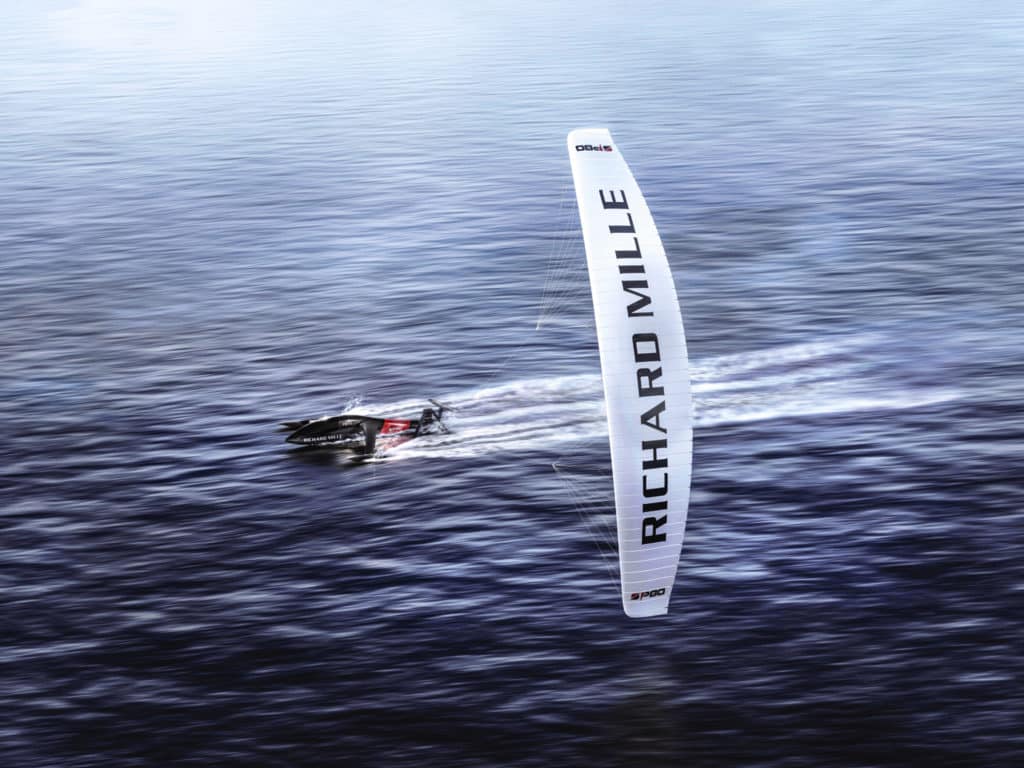
If Alex Caizergues succeeds at breaking the speed sailing world record in 2022, it will be his third time around using a kite, but otherwise completely different from his first two records. Those marks—50.57 knots in 2008 and 54.10 in 2010—were set when foiling boards were continually upping the 500-meter mark, sometimes more than once a year. Caizergues’ 2010 run added 3 knots to what the famed trimaran L’Hydroptere had shown us only a year before. But all those efforts ran into cavitation trouble at about 52 knots, that point when flow over the foils boils into vapor—the point at which control vanishes. For his early records, Caizergues used a hydrofoil to lift him above the water. Now, with his Syroco team based in Marseille, France, he intends to use a hydrofoil to hold him down.
We’ll come back to that.
Nine years after Paul Larsen’s record run at 65.45 knots in Sailrocket , the French Syroco team has rivals in Switzerland following what they believe is a more conservative path. The École Polytechnique Fédérale de Lausanne is a public research facility where the speed quest caught fire with student engineers and professors, including some who helped develop L’Hydroptere back in the day. SP80 is the team name, taken from the goal of achieving 80 knots, a goal shared with Syroco. They have a kissing-cousin relationship, competition aside.
SP80 envisions hitting 80 knots with a kite pulling a surface-skimming trimaran. A subsurface superventilating foil counters the lift of the kite, and a mechanical interface aligns the forces. Syroco’s purified vision aims to put a kite in the air connected by wires to a pod also in the air carrying two “pilots.” That pod will have a single, tiny-as-possible connection to a supercavitating subsurface foil holding it down. The concept strips the speed problem to its barest fundamentals, exponentially raising the complexity of execution.
Neither concept would pass as a boat in Blue Blazerville. Both owe their origins to Bernard Smith’s book, The 40-Knot Sailboat , published in 1963 . Smith proposed a balance of opposing forces to avoid the ultimate instability that eventually and inevitably develops as power is added, and any ordinary craft will capsize. Sailrocket showed the way and validated the theory—using a canted wing, countered by a superventilating foil in the water. On November 24, 2012, with sponsorship money down to nickels and the weather window closing, Larsen clocked his 65.45-knot run at Walvis Bay, Namibia. These days, Larsen says he appreciates the respect shown by the principals of SP80 and Syroco when they call themselves “children of Sailrocket .” But when we keep this Australian-born Briton talking, we get to the part where he’s saying how the machine was packed away in a container in Namibia after just a few days of finally showing its potential, and there’s still gas in the tank and…
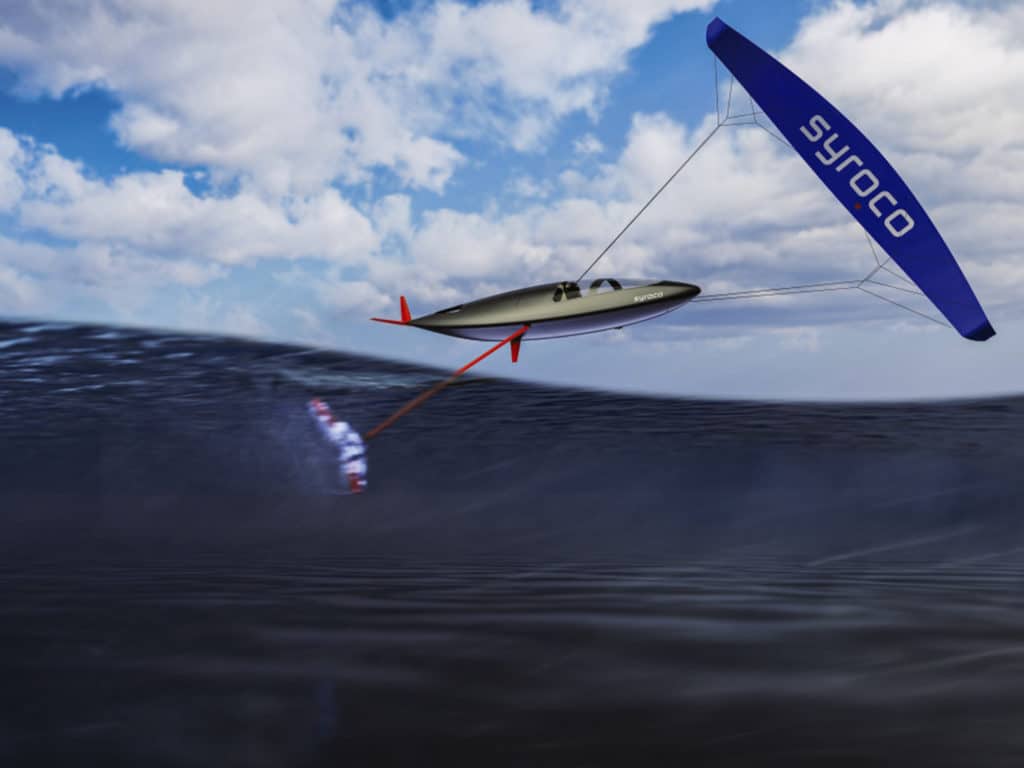
There’s nothing shaking right now, but don’t dismiss the current record holder, 49 years after the catamaran Crossbow set the first official 500-meter record at 26.30 knots. For bonus points, do you know how 500 meters became a standard record distance?
The simple answer: In 1972, when Crossbow was first contending at Weymouth, UK, that length fit the venue. If someone manages 80 knots in 2022, they will cover 500 meters in 12.15 seconds, a football field every 2.5 seconds.
Later, while we’re talking records, we’ll update the renovation of L’Hydroptere . First, let’s get up to speed on the essential terms. Supercavitation refers to a regime in which a small, highly loaded, wedge-shaped (triangular profile) foil builds a stable vapor pocket that bypasses the limits of cavitation. Superventilation refers to the principle employed by Sailrocket , with a foil that encouraged ambient air pressure to travel down the entire length and span of the foil.
The SP80 team puts it this way: “A triangular profile allows air from the atmosphere to dive into the extrados side caught by the depression, forming a stable air bubble that will prevent cavitation inception.”
Got it? Hey, they’re engineers.
Caizergues is aiming for more than a speed record with his Syroco concept. He knows from experience that when you succeed, you’re done and, “It’s an empty feeling.” This time, he’s ambitiously building a scientific and technical company around Syroco with the aim of reducing carbon emissions in the transportation and energy sectors. Co-founder Olivier Taillard, a Mini-Transat veteran, relates: “We founded the company in 2019 and built a team of 20. That includes three Ph.D.s in physics. To date, we have created 12 innovations, with three in the market. One is a software tool now in use to maximize efficiency in shipping routes.”
Other developments are aimed at keeping that critical hydrofoil just barely under the surface of the water, doing its supercavitating thing. Under the rules of the World Sailing Speed Record Council, only mechanical systems are allowed. It can’t be computerized or fly-by-wire. To a pointed question about systems, Caizergues responds with a laugh and a cagey hint: “Because of the wire, we’ll have air coming down from the surface, so it’s going to be about managing ventilation along with employing the principles of supercavitation. Not a lot of work has been done in this area, so we’re leading the way.” Prototype testing began in summer 2021, with plans to go for the record in 2022. Alongside more sober developments aimed directly at the marketplace, the team calls this one “the moonshot.”
When these people talk to each other, they toss around stuff like “turbulent viscosity formula in the Standard K-Epsilon model.” It’s not “let it out till it luffs, then pull it in.” SP80 co-founder Mayeul van den Broek observes: “Like Sailrocket , both of the current record efforts are based on the concept of aligning opposed forces, but then you prioritize either efficiency, power or stability. Syroco chose efficiency as a top priority. We chose stability, which is why we are producing such a different realization of the same concept.”
The SP80 principals witnessed L’Hydroptere ’s stunning record run in 2009 and never quite got over it. Then, during a university competition to design the most efficient radio-controlled boat, they developed a hankering to try a superventilating foil on a kiteboard. When Benoit Gaudiot easily hit 41 knots, van den Broek says: “We saw that the rider was the weak link, and if we wanted to go faster, we would need a rigid link between the kite and the foil. Then, well, we might as well go for the record. We will use inflatable kites, even though a wing might be more efficient, because new-generation kites will serve at 80 knots. We can be versatile, launching kites from 20 to 50 square meters for different conditions.”
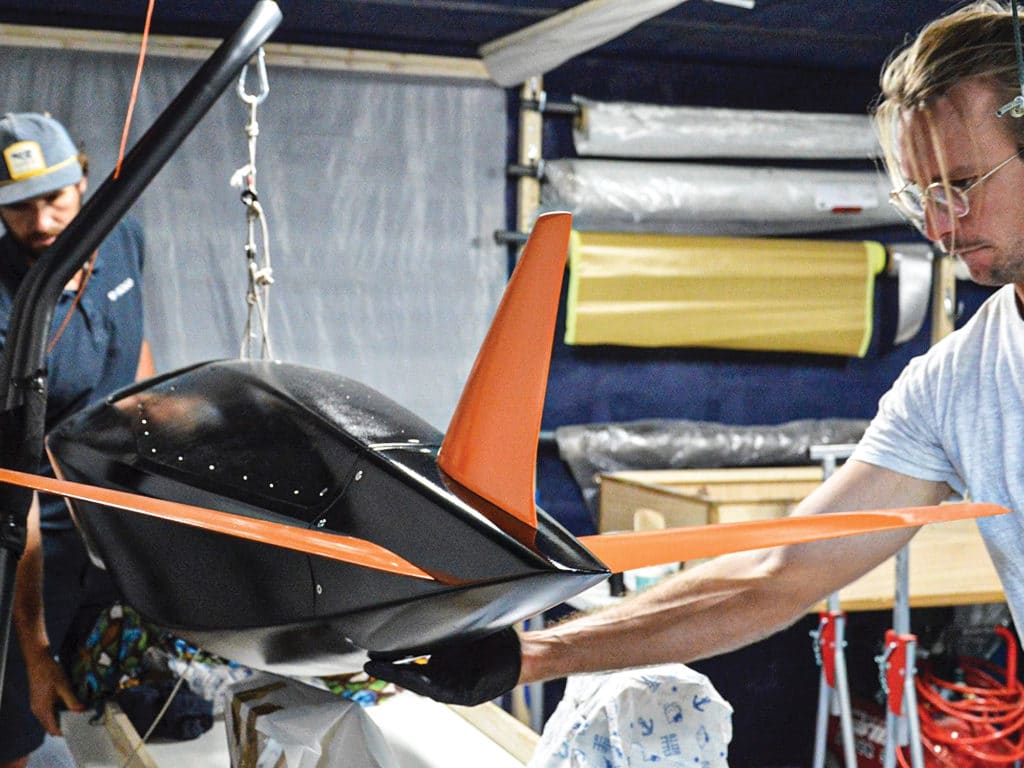
Their superventilating foils, Gaudiot says, “will have water flowing on one side and air on the other. Sailrocket used similar superventilating foils. That is less efficient than a supercavitating foil generating vapor, but it’s a lot more stable. A superventilating foil at low speed will develop more drag than a conventional foil. At high speed, it has no limits.”
SP80′s link between airfoil and hydrofoil depends upon a module that is, “mechanical but automatic,” according to van den Broek. “It will be close to the controls of a conventional kite.” Gaudiot adds, “Having one line carry all the power allows you to know exactly where that power will be coming from, and you can advance it into the window ahead for best performance, like any kite.”
In theory, there is no heeling and no capsizing because the power of the kite is countered by the force of the foil. As with Syroco, 2022 is the target record date.
Last year, we wrote in these pages about an ambitious plan to rehab the 60-foot foiling trimaran L’Hydroptere and put the old girl to work as a point-to-point record hunter. Gabriel Terrasse and Chris Welsh partnered to buy the legendary campaigner, once left derelict in Hawaii. They patched it up and had it sailed to San Francisco, where it was taken apart with an intent to rebuild it better than ever. Work was well along when Welsh—who would have carried on with or without sponsorship—died suddenly, and all bets were off, save for Terrasse’s persistence.
“We’re looking for sponsors,” Terrasse says, “and we have engineers studying how to add ground effect to L’Hydroptere 2.0 along with new foils, a longer and lighter main hull, a wingsail, global aerodynamic optimization and much more. It was hard to lose Chris. We shared the dream. But L’Hydroptere has great potential to serve science and catalyze innovation.”
L’Hydroptere ’s 51.36-knot run in 2009 represented a last shot at setting speed records on water through pure muscle. Paul Larsen’s nine-year quest to solve the problem at a technical level culminated in that 65.45-knot run in 2012. Today the beast is still in a dark container in Namibia where Larsen packed it away. And yes, considering that Sailrocket had only a handful of runs in what turned out to be record-setting mode—fat foils, not thin foils, and according to the team’s VPP, 65 knots was a worst-case outcome; everything was structured to go 80 knots—it’s tempting to imagine putting Sailrocket 2 back on the track. What would change is the safety regime. It’s not hard to find videos online of early-version Sailrocket 1 going aerial.
“In any future scenario, I’d want a roll cage and oxygen,” Larsen says, “and maybe I’m at a point where I’d be happy to see someone else sitting there.”
“Tell Paul he’s getting soft,” was the joking comeback from Richard Jenkins when I mentioned that to him. Jenkins holds the land-speed sailing record at 126.2 knots, which took him “only” 10 years of trying as his various iterations developed. As far as we know, no one is challenging that record today. Jenkins’ story speaks to the difficulty of these endeavors in any medium. He says: “I’m often asked if I would try to break the record again. If I had unlimited funding and built a new vehicle, based on my cumulative knowledge, it might take me five years or more, and then we’d probably see an increment of 1 or 2 percent. It takes being in the right place at the right time, with certified observers, which is hard to put together. You then have to be technically perfect, at the right moment, with virtually no testing because wind might come suddenly. It takes a great deal of time and experience—and then you shoot from the hip. I have better things to do.”
Running his company, Saildrone, for example, with which Jenkins does his own part to care for the planet by fielding autonomous surface vehicles for ocean research. Having built a kite-powered trimaran 20 years ago, Jenkins worries the Swiss are “barking up the wrong tree.” But technologies evolve, and 2022 bids to be a fascinating time. Of Syroco’s moonshot, Taillard says: “Half of our brain power is spent making it safe. If a foil breaks, or if it comes out of the water—which isn’t going to happen—all safety systems have to work perfectly.”
Caizergues, who will be in Syroco’s control pod with a co-pilot, adds: “One of the goals is to produce a craft that will be safe for me to drive. And to crash. Helmets, oxygen, padding, quick-release mechanisms for sure, and we’re not committed to air bags, but maybe.”
Syroco and SP80 intend to run in the south of France, where the Mistral roars down to the Med. It worked for L’Hydroptere , but these new efforts place ever more extreme demands upon managing the interface between air and water, which at sea level is 784 times the density of air. The world will be watching, and perhaps I speak for many when I say, “Gentlemen: May the alignments of force be with you.”
- More: print fall 2021 , Racing
- More Racing
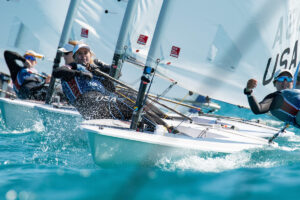
Reineke’s Battle For the Berth
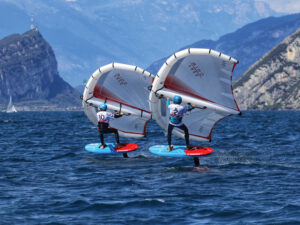
One-Design Wingfoil Racing Takes Off

Brauer Sails into Hearts, Minds and History
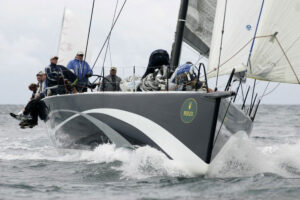
Anticipation and Temptation

America’s Offshore Couple

Jobson All-Star Juniors 2024: The Fast Generation

- Digital Edition
- Customer Service
- Privacy Policy
- Cruising World
- Sailing World
- Salt Water Sportsman
- Sport Fishing
- Wakeboarding

Discover the Magic of Hydrofoil Sailboats

Last Updated by
Daniel Wade
December 11, 2023
Key Takeaways
- Hydrofoil sailboats blend speed, stability, and innovation for a fun sailing experience.
- Their design lifts the hull above water, reducing drag and enabling high-speed travel.
- Advanced control mechanisms maintain stability in varying wind conditions.
- Sails and hulls are meticulously engineered for optimal aerodynamics and lift.
- Ongoing innovations in foil technology continue to propel hydrofoils to new heights.
Based on their innovation and nature, the world of hydrofoil sailboats are magical, to say the least. But what exactly makes them so exceptional?
The magic of hydrofoil sailboats lies in their extraordinary speed. They can achieve remarkable speeds that were once thought impossible for sailboats. Their unrivaled stability and cutting-edge technology redefine sailing, offering a thrilling blend of innovation and performance.
Over the years, I've dedicated myself to mastering the intricacies of the yachting world, not just as an observer but as an active participant in the hydrofoil sailing community. My knowledge extends beyond the surface, encompassing the technical aspects of hydrofoil design and the thrill of high-speed sailing. As such, I’ll provide a comprehensive and engaging exploration of what sets hydrofoil sailboats apart, making them truly magical on the waters.
Table of contents
Discover the Magic of Hydrofoil Sailboats
Hydrofoils saw their early development as a concept for enhancing speed and efficiency on the water. From Alexander Graham Bell's experiments to the application of foils on sailboats in the 1950s, the quest has always been for greater speed.
But it wasn't until Russell Long championed these designs with the CEC foiling catamaran and the development of the Hobie Trifoiler that hydrofoils began to carve a distinct niche in the sailing world.
This sailboat operates on a simple yet ingenious principle: as the speed increases, the foils submerged beneath the boat generate lift. This lift thrusts the boat's hull above the water, dramatically reducing drag.
It’s similar to how air flows around the wing of an airplane, only with water's denser environment offering a different dynamic. This revolutionary foiling system allows boats to glide over waves, offering an incredibly smooth ride.
The variety of hydrofoil sailboats is astounding, from the foiling catamarans that have revolutionized the America's Cup to the twin sail trimaran designs. The fastest production sailboat, the Hobie Trifoiler , showcases what hydrofoils are capable of.
Additionally, boats like the innovative Emirates Team New Zealand vessels continue to push the boundaries of technology in competitive sailing. Whether for recreational purposes or high-speed racing, the range of hydrofoil sailboats caters to different sailing experiences and preferences.
Now, let’s explore the various aspects of hydrofoil sailboats that make them truly magical.
The Thrills of Hydrofoil Sailing
When I first stepped onto a hydrofoil sailboat, I knew that sailing would never be the same for me. Harnessing the power of the wind to achieve remarkable speeds while hovering above the water was nothing short of revolutionary.
It's an adrenaline-infused blend of sailing, flying, and innovation that promises high performance and stability with a significant reduction in wetted areas.
The allure of hydrofoiling is not just about the speed; it's the sensation of flying over the waves, defying the conventions of traditional sailing. With each gust, my hydrofoil sailboat becomes a silent, swift car, slicing through the air rather than merely sailing on the water.
When sailing with hydrofoils, you get to experience the following benefits.
- High Speed: With hydrofoils, I've seen and achieved speeds I never thought possible on water.
- Less Wetted Area: As the hydrofoils lift the hull out of the water, drag is reduced, further contributing to the craft's efficiency and speed.
- Stability: Surprisingly, the flying sensation is accompanied by stability once airborne, making the ride smoother.
The America’s Cup Competitive Foiling
Over the years, I've witnessed first-hand how hydrofoil technology has radically altered the landscape of competitive sailing. The introduction of hydrofoils has not only redefined what we consider possible in the sail area but has also brought a fresh surge of excitement to the racing circuit.
The most illustrious event in sailing, the America's Cup , underwent a transformation with the embrace of hydrofoils. Emirates Team New Zealand, a frontrunner in hydrofoil innovation, redefined the America's Cup racing in 2017.
Alongside them, the US team and Luna Rossa played pivotal roles in reshaping the landscape of America's Cup racing.
With their AC50 class catamarans soaring above the waves at top speeds that defy traditional sailing limits, they clinched the title and shifted the focus of competitive racing toward technological prowess.
The spectacle of these vessels racing is not just about the crew's capabilities but equally a testament to engineering marvels.
Also, the advent of hydrofoils in racing has certainly led to a spike in performance metrics. Here's a concise table highlighting the before and after impact of hydrofoiling in competitive Sailing:
This table illustrates just how much the racing landscape has shifted; it's not only sailing anymore.
It’s similar to piloting a high-speed aircraft, with each crew member playing a crucial role in harnessing the raw power of the strong winds in harmony with state-of-the-art technology. Watch this video for a more detailed explanation of hydrofoil sailboats and their magical power.
Technical Aspects of Hydrofoil Sailboats
In diving into the technical aspects of hydrofoil sailboats, I'll give you an insight into the intricate designs that enable these marvels to glide above the water, as well as the cutting-edge foil technology propelling them.
The design of a hydrofoil sailboat revolves around its capability to elevate the hull above the water, reducing drag and enabling high wind-speed travel. Control mechanisms are central in maintaining stability, especially when the sailboat interacts with varying wind conditions or maneuvers through shallow waters.
The hull's length and overall design are calibrated for balancing aerodynamics with hydrodynamics. In designing sails and hulls for foiling, one must carefully balance the need for power with the propensity for lift.
The sails are tailored not only to harness the wind's energy effectively but also to match the unique mechanics of a vessel in flight. Meticulous engineering ensures that the sail configuration works in harmony with the foils to propel the sailboat forward swiftly.
Additionally, the foil technology, which is pivotal to modern hydrofoils, has undergone significant further development over the years . From the materials used to the manufacturing processes, every element incorporates the latest in technology to yield extreme performance.
Advancements have led to foils that can automatically adjust to sailing conditions and speed, which is instrumental for achieving and maintaining high speeds.
Currently, the future of hydrofoil technology seems bound for even further breakthroughs. Customization and refinement of foils for specific water conditions, such as the challenges posed by shallow water, are ongoing.
Each new iteration builds upon the last, consistently advancing the field and informing the next leap in hydrofoil sailing. This persistent innovation in foil and hull technology is a testament to the potential that lies ahead for hydrofoil sailboats.
Are Hydrofoil Sailboats the Right Options for You?
Hydrofoil sailboats offer a unique and thrilling sailing experience, but whether they are the right option depends on your preferences and goals. These high-performance vessels are known for their exceptional speed and stability, making them ideal for thrill-seekers and competitive sailors.
If you're passionate about cutting-edge technology and want to push the boundaries of traditional sailing, hydrofoil sailboats could be a perfect fit.
However, they may require a learning curve for beginners and are typically more expensive than traditional sailboats.
Consider your skill level, budget, and desire for speed and innovation when deciding if hydrofoil sailboats align with your sailing aspirations.
The Future of Hydrofoil Sailboats and Their Transformative Potential
Over the years, I've been captivated by the evolution of sailing and the recent advancements in hydrofoil technology, which promise a thrilling future for these marine crafts.
The technology supporting hydrofoil sailboats is rapidly advancing, bringing us closer to a world where boats gliding above the water's surface is a common sight.
These boats use 'wings' or foils submerged in water to lift the hull above the surface, reducing drag and allowing for greater speeds. This innovation is not just limited to racing but is expected to influence recreational and transport vessels in the future.
Today, we see hydrofoils in action with hydrofoil kiteboards, which have become popular among thrill-seekers. This is due to their ability to harness wind power and achieve impressive acceleration and agility on the water. This same principle is being applied to larger sailing vessels, where performance and sustainability converge.
The further development of hydrofoil technology involves intensive research into materials and design optimizations that can handle the challenges of varied sea conditions.
Electric and solar-powered hydrofoils are on the horizon, poised to significantly impact our world by offering greener alternatives to traditional boats.
Notably, the trends in hydrofoiling indicate a shift towards more sustainable sailing, utilizing advancements in electric propulsion systems to complement the inherent energy efficiency of hydrofoil designs.
The goal is a fleet of sailboats that are not just faster but more eco-friendly, promising an exciting future where the joy of sailing is in harmony with the health of our oceans.
Related Articles
I've personally had thousands of questions about sailing and sailboats over the years. As I learn and experience sailing, and the community, I share the answers that work and make sense to me, here on Life of Sailing.
by this author
Learn About Sailboats
Most Recent

Affordable Sailboats You Can Build at Home
September 13, 2023

Best Small Sailboat Ornaments
September 12, 2023
Important Legal Info
Lifeofsailing.com is a participant in the Amazon Services LLC Associates Program, an affiliate advertising program designed to provide a means for sites to earn advertising fees by advertising and linking to Amazon. This site also participates in other affiliate programs and is compensated for referring traffic and business to these companies.
Similar Posts

Hunter Sailboats: Are They Built for Bluewater Cruising?
August 29, 2023

What Is A Furler On A Sailboat?
August 22, 2023

What Is Sail Roach?
August 15, 2023
Popular Posts

Best Liveaboard Catamaran Sailboats
December 28, 2023

Can a Novice Sail Around the World?
Elizabeth O'Malley
June 15, 2022

4 Best Electric Outboard Motors

How Long Did It Take The Vikings To Sail To England?

10 Best Sailboat Brands (And Why)
December 20, 2023

7 Best Places To Liveaboard A Sailboat
Get the best sailing content.
Top Rated Posts
Lifeofsailing.com is a participant in the Amazon Services LLC Associates Program, an affiliate advertising program designed to provide a means for sites to earn advertising fees by advertising and linking to Amazon. This site also participates in other affiliate programs and is compensated for referring traffic and business to these companies. (866) 342-SAIL
© 2024 Life of Sailing Email: [email protected] Address: 11816 Inwood Rd #3024 Dallas, TX 75244 Disclaimer Privacy Policy
- THE PRINCESS PASSPORT
- Email Newsletter
- Yacht Walkthroughs
- Destinations
- Electronics
- Best Marine Electronics & Technology
- Boating Safety

Sailing’s Hydrofoiling Revolution
- By Herb McCormick
- January 18, 2023
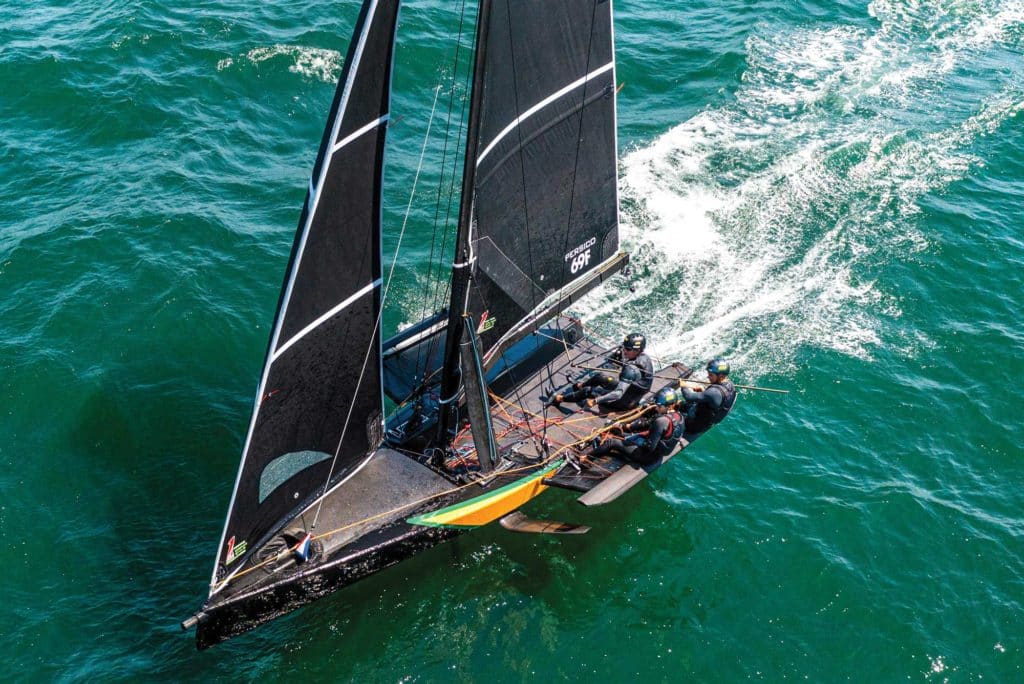
There’s a revolution underway in the sport of sailing, and it can be summed up in one simple word: foiling.
More specifically, we’re talking about hydrofoils , the winglike appendages mounted beneath the hull of a vessel that, at a certain speed, lift the hull clear of the water. When this happens, the foiling sailboats can reach speeds two or even three times faster than possible in “displacement” mode.
And sailboats are just one element of the foiling revolution: Surfboards, paddleboards and powerboats are also getting in on the act.
An Italian naval architect named Enrico Forlanini is credited with developing the first waterborne hydrofoils, which he affixed to a 60 hp, airscrew-driven craft that topped off at 36.9 knots back in 1906. In the century that followed, a series of would-be inventors took a swing at the concept with varying degrees of success. Foiling sailboats finally ascended into the mainstream during the 2013 America’s Cup, when Oracle Team USA beat Emirates Team New Zealand in a match between foiling 72-foot catamarans (the Cup has been contested in foiling cats ever since).
Surprisingly enough, my first foiling experience happened some three decades ago, aboard something called a Hobie TriFoiler, from the popular manufacturer of Hobie surfboards, beach cats and kayaks. The TriFoiler, basically a 22-foot trimaran with a central pod and a pair of mainsails stepped on the twin outriggers, was invented by a fanatical California engineer named Greg Ketterman. The sail controls were laid out just forward of the tiny airplane-style cockpit; you steered with foot pedals. It was so ridiculously easy that even a gremmie like me had the thing foiling within moments of getting in and reaching off.
But after the initial thrill, it was actually kind of boring. Which, I believe, is why it went out of production soon after. The TriFoiler was, unfortunately, way ahead of its time.
Such was the extent of my personal foiling experience until this past summer, when a new class of foiling monohull skiffs called Persico 69Fs rolled into my home waters for a series of races among youth squads in the class’s inaugural season. I got an invitation to take a spin.
After donning my helmet, wetsuit and life jacket, I was handed the helm with a pair of skilled young sailors on board. At 25 knots, we were towed into Narragansett Bay behind a powerful RIB, foiling all the way. It was terrifying. And a preview of coming attractions.
Once the tow dropped us, the sails went up and we bore off. I skied the tiller extension while scrambling out onto the hiking racks. Which sent us off on a screaming reach. Which flipped the 22-foot-7-inch carbon rocket ship.
Twenty seconds into foiling, and I’d capsized the bloody thing. How embarrassing.
The kids, bless them, were kind and patient. We got the whole shooting match, including ourselves, back upright and tried again. The mainsail trimmer sheeted it home, we started to accelerate, and he said: “Here we go! You’re up. You’re flying!” Indeed, we were.
Hard on the breeze in the 12-knot southwesterly, things unfolded quickly. Spray was flying, and I took more than one solid wave to the kisser. I was mostly too frightened to concentrate on anything but driving, but I did glance at the speedo once: 17.4 knots. (I felt pretty chuffed until later learning a 69F’s top speed is 34 knots. Ugh.)
However, I guess I’d proved the point: With a couple of sailors who know what they’re doing, foiling is for everyone. From now on, just call me Mr. Foiler.
- More: Foils , Hydrofoil Boats , Hydrofoiler , November 2022 , Sailboats , Sailing Yachts , Yachts
- More Yachts
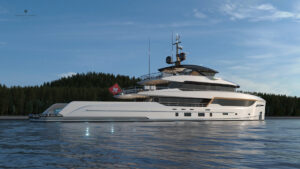
New Flagship for Bering Yachts: The B165
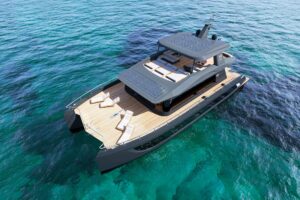
Power Catamaran Popularity Rising
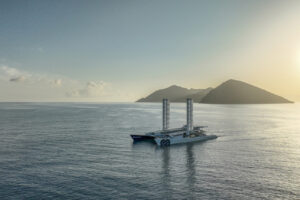
“Energy Observer” Zero-Emission Boat Showcases Sustainability
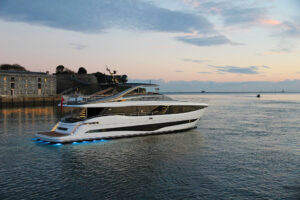
Princess Yachts’ Y95: A Flagship Flybridge
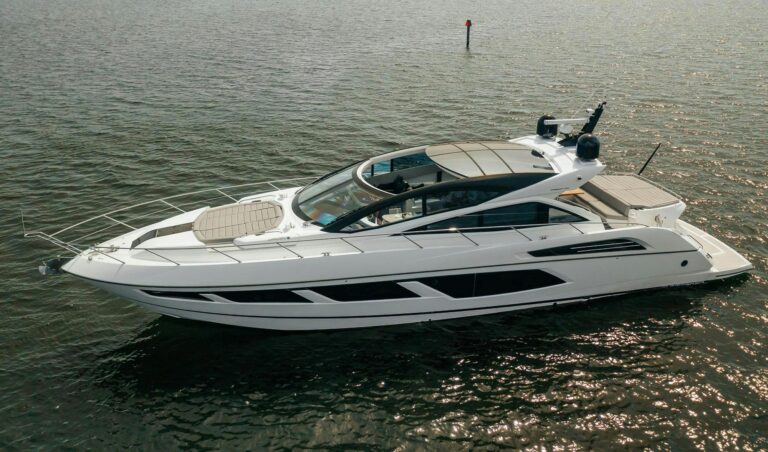
For Sale: Sunseeker Predator 68
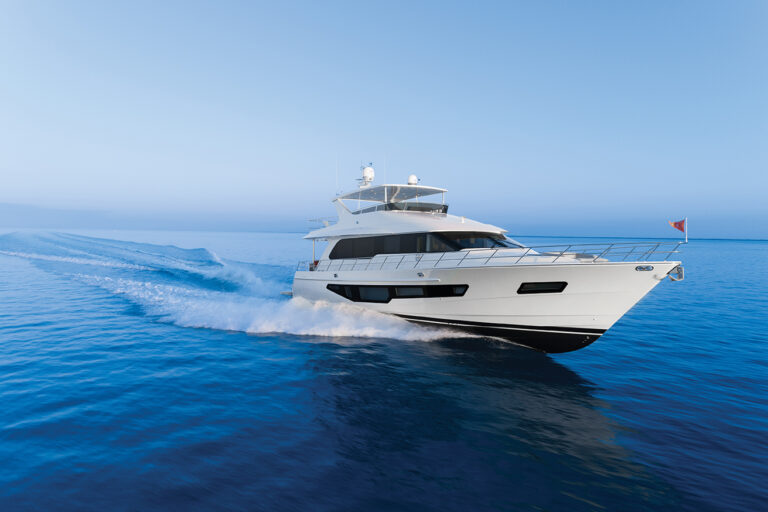
For Sale: CL Yachts CLB 72
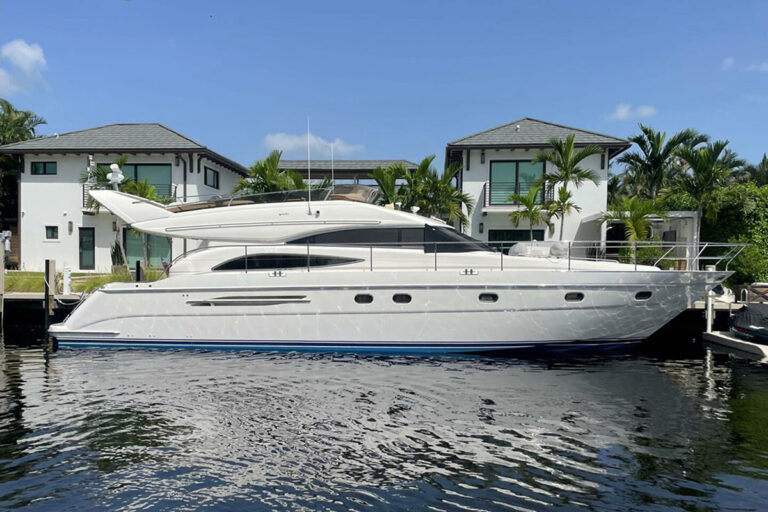
10 Yachts Under $500,000 You Can Have Today
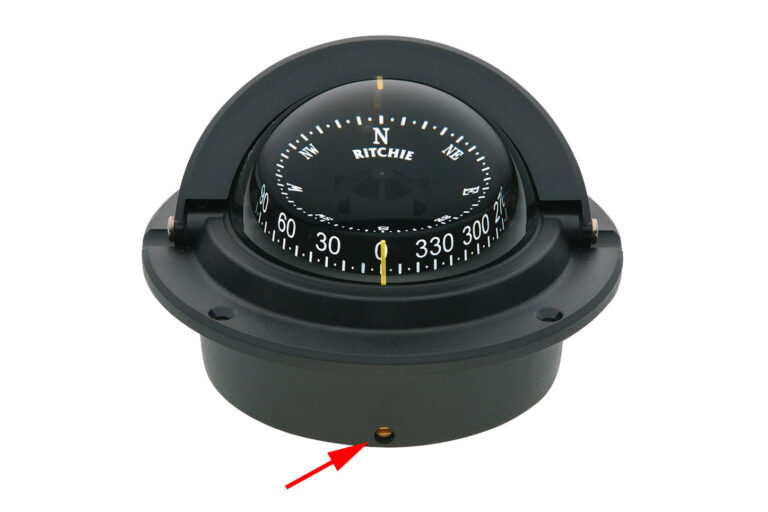
How to Swing a Compass on a Boat

- Digital Edition
- Customer Service
- Privacy Policy
- Email Newsletters
- Cruising World
- Sailing World
- Salt Water Sportsman
- Sport Fishing
- Wakeboarding

- Subscribe Now
- Digital Editions

Foiling technology: everything you need to know about hydrofoils
Fitting foils to powerboats is all the rage, but how do they work and why is foiling back in fashion?
What is foiling?
Foiling refers to the use of hydrofoils attached to the hull of fast boats, which provides additional lift at planing speeds – often enough to lift the hull completely clear of the water.
What is the benefit of this?
Efficiency. The enemy of fast boats is the amount of effort required to push them through the water. Planing boats go some way to addressing this by rising up over their own bow wave and skimming across the surface, but the stern sections are still immersed, creating significant hydrodynamic drag. It follows that if you can lift the boat completely clear of the water, hydrodynamic drag is only acting on the foils themselves and the sterngear that propels and steers it.
Any advantages beyond efficiency?
Lifting the boat clear of the surface can reduce the disturbance of waves, smoothing the ride, but only up to a point. It’s not just about lift though – active foils can also be used to improve stability or handling and in some circumstances, can improve efficiency even without lifting the boat.
Recommended videos for you
How do foils work.
Foils work in a similar way to aircraft wings. In simple terms, as they move through the water they deflect the flow, which exerts a force on the foil. If that force is upward, the faster they move, the greater the lift.
So why are they so much smaller than aircraft wings?
Because water is much denser than air – almost 800 times, in fact. The foils have far more to push against than aircraft wings, so don’t require the same surface area.

Is this new technology?
Far from it. Foiling technology can be traced back to 1898 when Italian inventor Enrico Forlanini began work on a ‘ladder’ foil system, obtaining patents in both the UK and the USA. He had a prototype operating on Lake Maggiore soon after. British boat designer John Thornycroft followed up with a series of scale models featuring stepped hulls and a single foil, and by 1909 had a full-scale 22ft prototype running. During WWII, the German military developed a 17-tonne foiling mine layer that was tested in the Baltic at speeds of up to 47 knots. By the early 1950s, the first commercial hydrofoil ferry was running between Italy and Switzerland and a decade later, a private hydrofoil yacht featured in the Bond movie Thunderball.
Why did they never catch on in production boating?
Traditionally, high-speed hydrofoils used large V-shaped foils that jutted out beyond the boat’s beam. This made berthing tricky and increased the draught. They were also costly to construct, vulnerable to damage and difficult to power, as the propellers of conventional shaftdrives would be clear of the water once foiling. Lastly, although hydrofoils were often more efficient than monohulls, high-speed cats could usually match the efficiency without the drawbacks.
Why are they back in the news?
Foiling technology came back into public focus when the 2013 America’s Cup contenders started to use foil-shaped daggerboards to hit speeds of more than 40 knots. Ben Ainslie’s spectacular last-gasp victory for the Oracle USA team and his subsequent BAR Land Rover Cup Challenger brought foiling to a global audience. More recently, we’ve seen the emergence of several foiling motor boats, including the SEAir RIB and the Sunreef Open 40 Power. More exciting still is the news that Princess will use an advanced Active Foil System on its new R Class superboat .
What has changed?
Technology has overcome many of the shortfalls of older systems. Simon Schofield, chief technology officer at BAR Technologies, told MBY the real game changer has been the adoption of ‘Dalí’ foils. Instead of two fixed V-shape foils, Dalí foils use four independent L-shaped blades that stick out of the hull at an angle before curving up like Salvador Dalí’s famous moustache. They are far more efficient and can be retracted, solving the berthing and draught issues. In addition, computer-controlled active systems allow the foils to be adjusted to suit speed and sea conditions. This doesn’t just improve efficiency, it can enhance the ride and handling too. When cornering, for example, a traditional hydrofoil boat doesn’t lean into the turn, making it uncomfortable for passengers. An active system can adjust each foil to induce the correct degree of lean. Modern materials also reduce drag and cavitation.
How about propulsion?
The Enata Foiler uses twin BMW diesel 320hp engines, but instead of being connected to the propellers with hefty drag-inducing shafts and gearboxes, these generate electric power which can be sent down a thin flexible cable to slender electric motors mounted on the retractable rear foils.

Lifecord – The kill cord revolution
Lifecord, a new alarmed smart kill cord that knows when you are not wearing it, ensures you’ll never forget to
Motor boat stabilisers: DMS’s new stabilisation fins
DMS's new flapping fins could become a staple for motor boats
Hybrid heaven: Adler’s 76 Suprema
Taking diesel electric propulsion to a new level, Adler's 76 Suprema may just be too innovative for the yachting marketplace
The world’s biggest electric foiling boat is coming
Sliver bullet first look – 130ft foiling boat with spaceship looks, toy of the month: pelagion hydroblade is the foiling tricycle of the future, latest videos, navan s30 & c30 tour: exceptional new axopar rival, galeon 440 fly sea trial: you won’t believe how much they’ve packed in, parker sorrento yacht tour: 50-knot cruiser with a killer aft cabin, yamarin 80 dc tour: a new direction for the nordic day cruiser.
MAIN FUNCTIONAL REQUIREMENT: Lift the boat’s hull outside the water.
DESIGN PARAMETER: Hydrofoil (It is a foil or wing under water used to lift the boat’s hull until it is totally outside the water.)
GEOMETRY/STRUCTURE:
EXPLANATION OF HOW IT WORKS/ IS USED:
1. At low speeds the hull (body of ship) sits in the water and the hydrofoils are totally submerged in the water.
2. As the boat’s speed increases, the hydrofoils create lift.
3. At a certain speed, the lift produced by the hydrofoils equals the sum of of the boat and cargo weights. Therefore the hull comes out of the water.
4. Instead of having an increase in drag with increasing speed because the hull is lifted out of the water (contrary to what happens in traditional boats due to pressure drag), the hydrofoils provide a more efficient way of cruising. Decreasing the drag contributes to the better use of the power needed for the movement of the boat.
DOMINANT PHYSICS:
How is the lift produced - Fluid Dynamics.
For the purpose of this project two explanations will be presented in a general and basic way. These theories are the application of Bernoulli’s Equation and Euler’s Equation for Streamline Curvature Effect.
Bernoulli’s Equation: Po = P 1 + � r v 1 � + r gy 1 = P 2 + � r v 2 � + r gy 2
This equation applies to flows along a stream line which can be modeled as : inviscid, incompressible, steady, irrotational and for which the body forces are conservative. Also the difference on the height of the foil (the distance from the bottom section to the upper one) is small enough so that the difference r gy 2 - r gy 1 is negligible compared to the difference of the rest of the terms. What is left is that the pressure plus one half the density times the velocity squared equals a constant (the stagnation pressure) . As the speed along these streamlines increases ,the pressure drops (this will become important shortly) . The fluid that moves over the upper surface of the foil moves faster than the fluid on the bottom. This is due in part to visous effects which lead to formation of vertices at the end of the foil . In order to conserve angular momentum caused by the counter-clockwise rotation of the vortices, there has to be an equal but opposite momentum exchange to the vortex at the trailing edge of the foil. This leads to circulation of the fluid around the foil. The vector summation of the velocities results on a higher speed on the top surface and a lower speed on the bottom surface. Applying this to Bernoulli’s it is observed that, as the foil cuts through fluid, the change in velocity produces the pressure drop needed for the lift. As it is presented in the diagram, the resulting or net force (force= (pressure)(area)) is upward.
This explanation can be enriched with the Principle of Conservation of Momentum. (Momentum = (mass)(velocity)) If the velocity of a particle with an initial momentum is increased, then there is a reactant momentum equal in magnitude and opposite in direction to the difference of the momentums. (See diagram). (Mi = Mf + D M) Euler’s Equation: d(p+ r gy)/dn = r v�/R
Here again, the term referring to the height is assumed negligible compared to the other terms in the equation. This equation says that as you go further from the center of the radius of curvature of a streamline, the pressure on the streamlines increases. The upper surface of the foil is closer to the center of curvature of the streamlines , therefore there will be a lower pressure than the ambient pressure above the foil. The difference between the pressure on the top surface and the ambient pressure at the bottom surface will produce a net pressure that will cause the lift.(See diagram.)
Angle of Attack:
As it has been presented, lift comes from the dynamics of the fluid in the area surrounding the foil. But the lift can be optimized by positioning the hydrofoil at an angle (relative to the incoming fluid flow) called the angle of attack (See diagram). The goal is to optimize the lift to drag ratio. This ratio depends on the shape of the foil, which in this case is considered to be a thin foil. With a small angle of attack, the lift increases rapidly while the drag increases at a small rate. After an angle of ~ 10� the lift increases slowly until ~ 15� where it reaches a maximum. After ~15� stall can set in. When the angle of attack is 3� to 4� the ratio of lift:drag is at it’s maximum. So the foil is more efficient at those angles (3�and 4�) with lift to drag ratios of ~ 20 to 25:1
LIMITING PHYSICS:
At first, people can think that stalling is likely to be a problem in hydrofoils as it is in airfoils, but surprisingly it is not. A steep angle of attack is not needed in the design of the hydrofoil. On the contrary, small angles of attack are used on hydrofoils to optimize the lift to drag ratio as explained before.
What is a primary concern is the design of the foil, the struts/supports, and their positioning. All these features have to be taken in consideration. So the features are designed to produce a minimum speed that will lift the boat of certain weight and keep it foilborne.
One problem that a hydrofoil craft can experience is the height of the waves being greater than the struts. Also, if the craft is traveling faster than the waves, the foils could break to the surface and outside of the water, resulting in a loss of lift and a negative angle of attack when the foil dives into the next wave, making the craft crash into the sea. Engineers have designed hydrofoils to minimize these limitations and better the ship’s performance.
PLOTS/GRAPHS/TABLES:
None Submitted
SOME HYDROFOILS AND THEIR USE:
Hydrofoils have become very popular. They are used in various kind of sea traveling, from military use to watersports. The high speed, smooth cruise and better turns delivered by hydrofoils have been used in military ships. Sailing has also adopted the hydrofoils to gain more speed. They enable new inventions that can satisfy people’s desire to challenge danger , like the sky ski. It is a water ski with a hydrofoil attached which permits people to fly above the water surface. Every day more hydrofoils are used, and in the future, they may be the dominate method of sea traveling.
REFERENCES/MORE INFORMATION:
See also on this site: Airfoil , Sailboats
Alexander, Alan, James Grogono, and Donald Nigg; Hydrofoil Sailing . Juanita Kalerghi: London, 1972.
Bertin, John and Michael Smith; Aerodynamics for Engineers, Third Ediotion . Prentice Hall: New Jersey, 1998.
Hook, Cristopher and A.C. Kermode; Hydrofoils . Pitman Paperbags: London, 1967.
The International Hydrofoil Society’s Web Page: http://www.erols.com/foiler/index.html
- Yachting World
- Digital Edition

Fastest sailboats: The teams aiming to break 80 knots
- April 6, 2022
It's been nearly a decade since Sailrocket set a new record to become the world's fastest sailboat. Now two teams are hoping to set a new record with their radical designs, Mark Chisnell reports
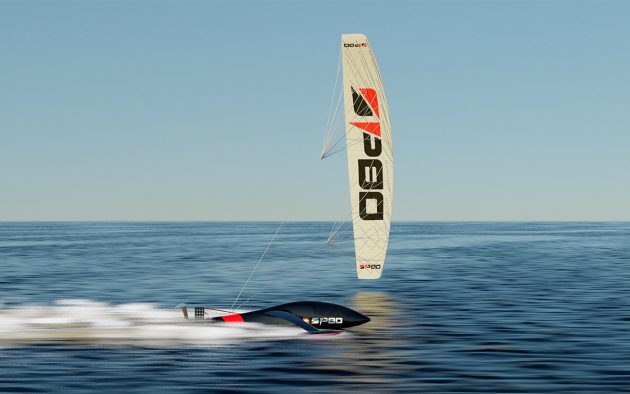
On 24 November 2012, Paul Larsen and his Sailrocket team rewrote our understanding of the physics of sailboats, stamping their names indelibly in the record books as they set a new record for the world’s fastest sailboat.
A little over a week earlier, at a spot called Walvis Bay on the coast of Namibia, Sailrocket 2 had pushed the outright sailing speed record up by the biggest-ever margin – from 55.65 to 59.23 knots. The performance on the 24th smashed it beyond all expectations though, a gloriously windy day that saw Sailrocket 2 deliver a 65.45 knot average officially becoming the world’s fastest sailboat.
It was a remarkable human achievement, piloting a boat down a 500m course at speeds that had previously been thought impossible. “Your job is to go 100% down that course, there’s no halfway about it,” Paul Larsen told me, almost a decade later. “By the time you’ve got a big team and all the momentum of that project going, your biggest fear is not going fast.”
The risks are inescapable though, as Larsen had revealed in a blog; “As I lay awake in bed that morning I considered writing a little note that I hoped would never be read and stashing it somewhere. Too morbid. Just get it right, Larsen.”
Growth of the world’s fastest sailboat
To put Sailrocket’s performance into context you need to consider the trajectory and history of the sailing speed record . It started back in 1972 with Tim Colman and Crossbow setting an opening mark of 26.30 knots.

Yellow Pages in 1993. Photo: Frederick Clement/DPPI Media/Alamy
By 1993, Yellow Pages had upped that all the way to 46.52 knots – an average improvement of almost a knot every year. But then something changes, progress halts for over a decade. The windsurfers and kiteboarders eventually start nudging it back up, but it’s 16 years before another yacht – Alain Thebault’s foil-borne L’Hydroptère – sets a new record, not even five knots quicker than Yellow Pages .
It was thought that the speed of sailing machines was reaching a ceiling, a physical limit defined by the cavitation point. If you have ever made a cup of tea at altitude then you will know that the boiling point (the transformation point where water changes from a liquid into a vapour), varies with pressure. The lower the pressure, the lower the temperature required for water to boil. So, at the top of Everest, water will boil at about 68°C.
There’s also low pressure on the leeward side of an aero- or hydrofoil . Foils provide a lifting force because of the pressure difference between one side and the other. This difference creates the force as the foil tries to equalise the pressure.

L’Hydroptère claimed the record in 2009. Photo: Christophe Launay
If a hydrofoil goes fast enough then the pressure to leeward will drop sufficiently that the water starts to ‘boil’ or vaporise. This creates a loss of lift, and instability as smooth flow turns chaotic, with vapour bubbles flowing down the foil to an area of higher pressure where they collapse.
It’s this speed limit that we see America’s Cup and SailGP foilers hit on a reach. Once the speed gets much above 50 knots the foils – which are designed to suppress cavitation for as long as possible – finally start to cavitate and the boats just can’t go any faster.
To get past this point a completely different type of foil is required, one that does not try to eliminate cavitation but instead tries to stabilise it, and this is the secret to the 65-knot speed of Sailrocket 2 . “That’s the brilliant [foil] design that we settled on, with a lot of help from guys like Aerotrope and Chris Hornzee-Jones. Chris did amazing work behind the scenes on that project, including designing the final foils,” said Larsen.
Article continues below…

Syroco: Radical design aiming to set a new speed record
If having a top-flight speed sailor as a part of your team taking on the challenge of creating the world’s…
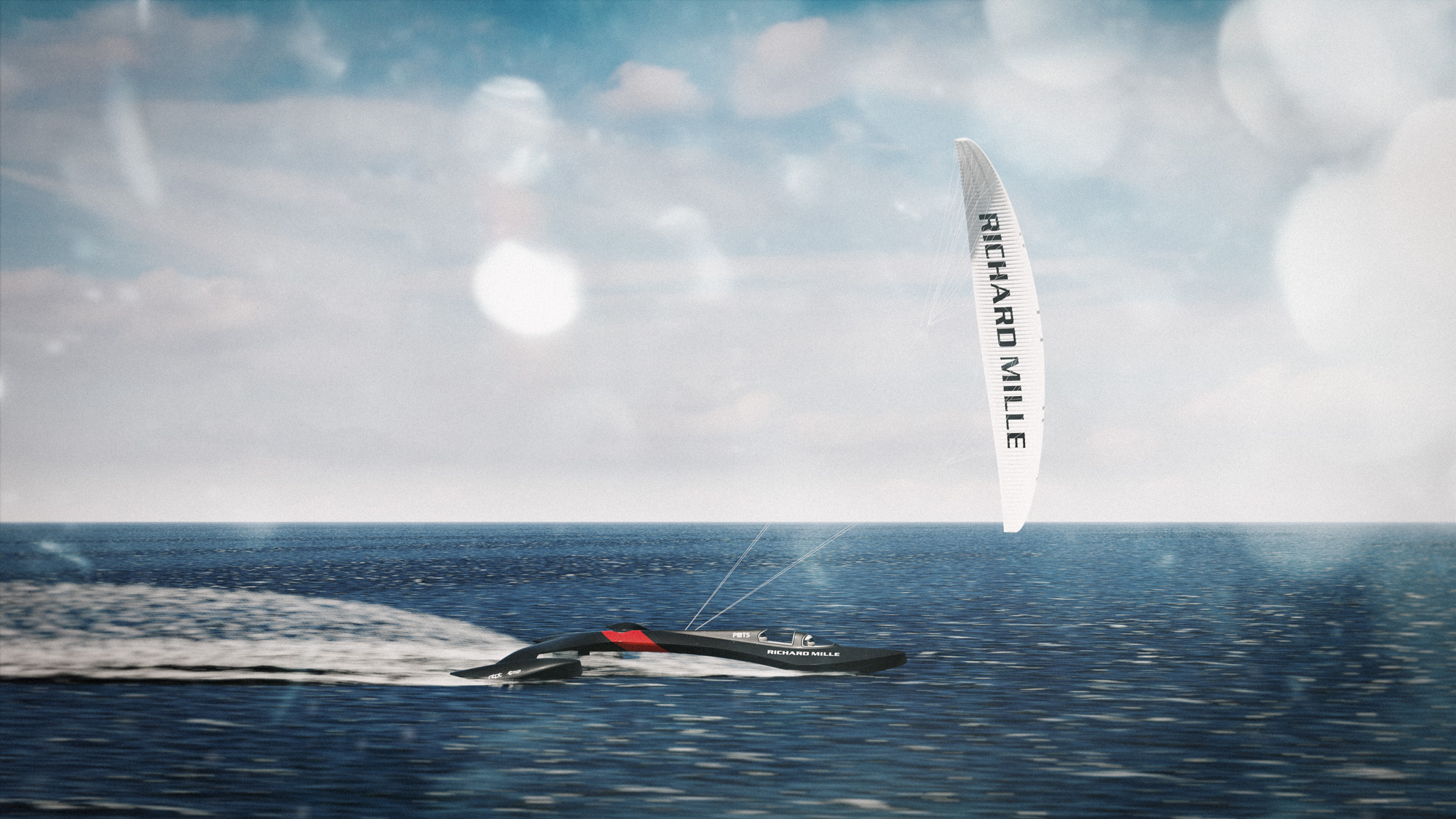
SP80: Swiss team hoping to build the fastest sailboat
SP80 was conceived by three graduates of Swiss engineering school, École Polytechnique Fédérale de Lausanne; Benoît Gaudiot, Xavier Lepercq and…

Sailrocket obliterates world record….again
Matthew Sheahan talks to Paul Larsen shortly after he exceeds 65 knots, shattering his own world record
The team realised the foil didn’t need to be impossibly thin to suppress and avoid cavitation. Instead, they could encourage it and push past the cavitation point with a foil that would cavitate in a stable fashion.
“To make a dinghy or a powerboat analogy, it’s like when you get over that hump and the boat gets up on the plane. We all know when the water separates off the back of the boat, you don’t want your transom gurgling around at the back there with all that drag,” Larsen explains.

Current speed record holders Paul Larsen and Vestas Sailrocket 2. Photo: Vestas SailRocket
In a similar fashion, Sailrocket 2 ’s foil is able to shed the turbulent, draggy flow of early cavitation and replace it with a single smooth pocket of vapour around the foil as air sucks down from the surface. Larsen calls this a base ventilated foil, it’s also sometimes termed a super-ventilating foil.
“So you end up with these very shallow camber, base ventilated foils, and they’re not overly efficient but they don’t have a limit,” he explained. “They keep working. It’s like a jet fighter’s wings. They’re not efficient, but if you put a big jet engine behind them, they keep going where the others stop and hit the ceiling.”
Force alignment
The jet engine was the other part of the problem. How do you generate enough power from the aerofoil to push a horribly inefficient hydrofoil up to the speeds required to start cavitation, and then blow through that barrier?
The answer lay in a decades-old idea – force alignment. In conventional sailboats, be they dinghies, multihulls or yachts, the aerodynamic force created by the sails is both pushing the boat forward and pushing it over.
The force is resisted by a combination of a hydrodynamic force from a foil in the water, and weight – either the crew’s bodyweight or the weight of a keel. These two forces act at a distance from the centre of effort of the sail – creating opposing levers, with the forces of mass and hydrodynamic lift opposing the aerodynamic force generated by the sail (or wingsail).
The use of these forces to create a propulsive forward force demands a structure of a commensurate size and strength. So to go faster required more force and/or lighter overall weight, but also stronger structures. It was big improvements in the strength and weight characteristics of materials that allowed much of the jumps in speeds set through the 1970s, 80s and 90s.

Vestas Sailrocket 2 used force alignment to achieve her remarkable speeds
But there was another way: by offsetting the forces and aligning them. “So [you] have the centre of effort of the aerodynamic forces, the sail or the wing, directly aligned with the opposing force of the foil,” explains Larsen. In other words, remove the levers by having the force from the sail directly oppose the force from the hydrofoil.
“We didn’t come up with that concept, that was written about in the 1960s by Bernard Smith in the book The 40-Knot Sailboat ,” Larsen adds. Smith’s insights were so far ahead of his time that it took almost five decades for them to be fully realised in Sailrocket 2’s record.
Sailrocket 2 achieved the force alignment with a wing mounted on the leeward hull that was canted over the windward hull by 30°. The force it generated was driving the boat forward and trying to lift the windward hull out of the water.
This force was resisted by a foil under the windward hull. And so that foil was pulling down rather than pushing up. It’s a crucial distinction between Sailrocket 2 and the type of foiling craft used in the America’s Cup or SailGP. In those boats, it’s the leeward hydrofoil that pushes back against the sail force. It also lifts the whole boat up and out of the water.
These two breakthrough ideas – force alignment and super-ventilated foils – along with a ‘no guts, no glory’ attitude, took Larsen and his Sailrocket 2 team over 65 knots, a mark that has been held for almost a decade. But might the time have come for that record to be broken?
“I think we’ve sat on it for long enough and it’s definitely time for it to be challenged,” Larsen says. “There was a time I was quite protective and proud of it, and wanted to sit on that throne for a while. But right now I want to see what other people can do with it and see what their solutions might be. I’ll see if it motivates me enough to get back out there myself!”
New fastest sailboat challengers
There are two major challenges shaping up to take on the Sailrocket team’s record and both should take to the water later this year or early in 2023. One of them, Syroco , has been set up by Alex Caizergues, the first man to travel sail-powered at over 100km/h on water, and twice holder of the outright sailing speed record on his kiteboard. The other, SP80 , has come out of the Swiss engineering school École Polytechnique Fédérale de Lausanne (EPFL).

Kite-powered SP80 challenge uses a super-ventilating surface piercing foil. Photo: SP80
Both are using the principles that Larsen established, and both teams think they won’t just break the record but will smash it. Syroco ’s stated target is 150km/h, a breathtaking 80.99 knots. SP80 is also chasing the 80-knot barrier.
“I actually like where both projects are aiming,” said Larsen. “They’re definitely using the force alignment concept.” Both the SP80 and Syroco teams will use a kite, aligning its aerodynamic force with the hydrodynamic force from a foil. This should allow the generation of an immense drive force on a relatively light structure. They will need all the power they can get to push through the cavitation point.
The SP80 project is also using a super-ventilating, surface piercing foil like Sailrocket’s. “Vestas Sailrocket and the work done by Paul Larsen and his team was the main source of inspiration that we used to develop the boat,” said Benoît Gaudiot, one of the three founders of SP80 .
They started throwing around ideas in 2017, building super-ventilated fins for a kiteboard. Gaudiot, an experience kitespeed sailor quickly got it to 41 knots. They were going to need a different approach to beat the record though.
“The body cannot handle the power that is required to reach more than 60 knots,” said Gaudiot.

SP80 co-founders Xavier Lepercq, Mayeul van den Broek and Benoît Gaudiot. Photo: SP80
Another of the founders, Xavier Lepercq, built a simulation tool, and they started developing designs. What they came up with was a trimaran powered by a kite, whose aligned force was balanced by a surface-piercing foil.
Once this was formulated the team quickly grew, with EPFL pledging its support and sponsors coming on board. “In the team, we have six full-time employees and almost 40 students from EPFL,” explained Mayeul van den Broek, the team’s project manager. They tested a prototype on Lake Geneva in 2020 and in June 2021 began construction of the full-size craft at Persico Marine.
The transition to a kite means that the biggest challenge to both teams is control – accurately balancing the aero and hydrodynamic forces. SP80 has tackled it with what they call the ‘power module’. “The idea behind this is to balance the force. The way we designed the boat, the main thing to achieve was stability,” said Gaudiot.
The exact mechanism of the power module is confidential, but it’s visible at the back of the boat in their visualisations and animations. It provides a direct link between the kite and the hydrofoil and appears to ‘trim’ the hydrofoil depending on the force vector coming from the kite. The shape of the foil and the linkage to the power module are key to the flight stability of the craft.

Swiss SP80 team has been testing its prototype on Lake Geneva. Photo: SP80
“It’s fully mechanical and it’s fully adjusting the balance by itself,” said Gaudiot. “The controls will be quite simple for the pilot. There will be no need for me to control the height, the elevation of the boat, just the direction. And the power of the kite.” The kite lines will run to the cockpit and be controlled with the hands, while the direction of the boat will be controlled with the feet.
The SP80 team plan to challenge the record from a base in the south of France early in 2023, and Paul Larsen is looking forward to it. “I think the SP80 is a more practical solution that has made compromises for practicality. And I think I can get my head around that one a bit more. I think SP80 is probably closer to getting results. And I want to see how a kite’s going to go against the [Sailrocket] wing, because historically wings are faster.”
Flight on water
Looking to spoil the Swiss party is Syroco , a French company that comes to the world sailing speed record with gold-plated credentials. Co-founder and CEO Alex Caizergues has already held the record on his kiteboard.
“Since Paul broke the sailing speed record, I knew that we had to change the software and the way to go fast on water. I knew that I had to assemble around me a team of people able to build this kind of craft,” Caizergues recalls.
Caizergues isn’t just an athlete, he’s a business school graduate with an entrepreneurial track record. Syroco was set up in 2019 with four co-founders and support from technology entrepreneurs and venture capitalists.

Artist’s rendering of how the Syroco craft will look in action. Photo: Syroco
They want to do more than just break the record, building a technology business around the attempt. The team has about 15 people working in Marseille with specialists in fluid mechanics, structures, software and data analytics.
“Our l’aile d’eau concept… it’s a little bit like Sailrocket,” said Caizergues. The concept is very simple; a hydrofoil will ‘fly’ underwater, pulled along by a cable that’s connected to a kite flying in the air above it.
Suspended between the two is a capsule containing the pilot Alex Caizergues, and a co-pilot. The aero and hydrodynamic forces oppose each other in an almost perfect representation of the aligned forces concept that powered Sailrocket 2 .
It should have the greatest speed potential because there is nothing extraneous. The capsule is only there because both the aero and hydrodynamic wings must be controlled, and the forces balanced by the pilots (not automated).

The Syroco prototype under test being towed by a RIB. Photo: Syroco
And that’s the tough part, controlling it, particularly keeping the foil in the water. “Nope,” responds Alex, quickly, when I mention this possibility. “The foil never goes out of the water.” The Syroco foil isn’t surface piercing, it runs below the surface, only connected to the capsule and the kite by a cable.
It doesn’t rely on dragging air from the surface to stabilise the cavitation around the foil. Instead, it will rely on the cavitation creating its own stable pocket of water vapour around the foil – this is called super-cavitation. When it occurs the water flows around the bubble of vapour as though it were a solid, significantly enhancing the performance of the foil – as long as the bubble remains stable.
The problem is keeping the bubble intact. Paul Larsen pointed out that the cable gives the air a pathway down to the super-cavitating foil. “How they’re going to stop air sucking down from the surface and rupturing the bubble, that’s the real trick. It’s a very dynamic problem to solve. It’ll be interesting to see how well their simulations live up to the reality of what they’re about to strap themselves into…”
The control mechanisms for the final craft are still being worked on, but they have flown a prototype, towed by a RIB rigged with a 5m-high mast that simulated the force from the kite. The team hopes to commit to a final design with construction starting in the spring.
Human element
And then of course, there will be the matter of executing the plan on the day. “If you’ve done your maths, you’ve done your engineering, you’ve been thorough, that gives you confidence when you stand up on top of that course on one of those big days and you’re not exactly sure what’s about to happen,” recalls Larsen.

Kiteboarder and businessman Alex Caizergues leads the Syroco project. Photo: Syroco
“You know it’s probably just slightly above your top wind range but all the cameras are rolling and the drones are in the air and everyone’s waiting with their stopwatches. That gives you the confidence to say: ‘Yeah, I’m going to go and wring its neck.’”
“Any crashes I had [and there were several] usually all the systems I had in place [for safety] were still completely locked on among all the wreckage. You’d go and flick off that lever you were going to use to control something – because by the time you’ve realised what’s happening, it’s happened.”
“If we go again with Sailrocket, then safety will feature bigger. I wouldn’t get in that boat and go that speed again. We got away with it because we had to.”
“Safety is really important for us,” agrees Benoît Gaudiot. They have built a kevlar cockpit for protection, installed a six-point harness and an F1-inspired seat. Gaudiot will wear a helmet with oxygen that will switch on if the helmet detects water in contact with its mask. “I would be able to stay in the water for a few minutes to have a diver come and open it.”
“The critical point on the boat is the hydrofoil. If the hydrofoil breaks, the boat…” Van den Broek interjects. “…will take off,” Gaudiot finishes the sentence for him.
Their enthusiasm for the project is infectious, the words tumbling out. And no one wants the boat to take off. One big advantage that they have that Larsen did not, is that they can release the power source. “With a kite it’s a few lines and you can just cut it super-fast,” says Gaudiot. “You can do it by yourself. You can do it from a distance, from the chase boat. You can do it automatically.”
“I think both those guys [Caizergues and Gaudiot], they’ve got the mentality,” said Larsen. “They’re not going to get up there and be scared of what they’re doing or intimidated too much by the craft.”
And what if they do break the record that Paul Larsen and his team have owned for almost a decade?
“We opened the door on a whole new world full of potential. And so there is a part of me that’s curious as to what lies further down that path. We validated the concepts that could get above what people thought were the cavitation limits and the ceilings of speed sailing. We proved you could get beyond that. They can take you to new levels of physics.
“The boat [ Sailrocket 2 ] is sitting there in perfect shape. It was made to last forever… we could rig that thing up and do 65 knots in a week or two.” And if his record goes, I wouldn’t put it past him to dust her off and do just that.
If you enjoyed this….
Yachting World is the world’s leading magazine for bluewater cruisers and offshore sailors. Every month we have inspirational adventures and practical features to help you realise your sailing dreams. Build your knowledge with a subscription delivered to your door. See our latest offers and save at least 30% off the cover price.
- BOAT OF THE YEAR
- Newsletters
- Sailboat Reviews
- Boating Safety
- Sailing Totem
- Charter Resources
- Destinations
- Galley Recipes
- Living Aboard
- Sails and Rigging
- Maintenance
- Best Marine Electronics & Technology

Hydrofoils for Sailboats
- By By Steven Callahan
- Updated: July 29, 2020
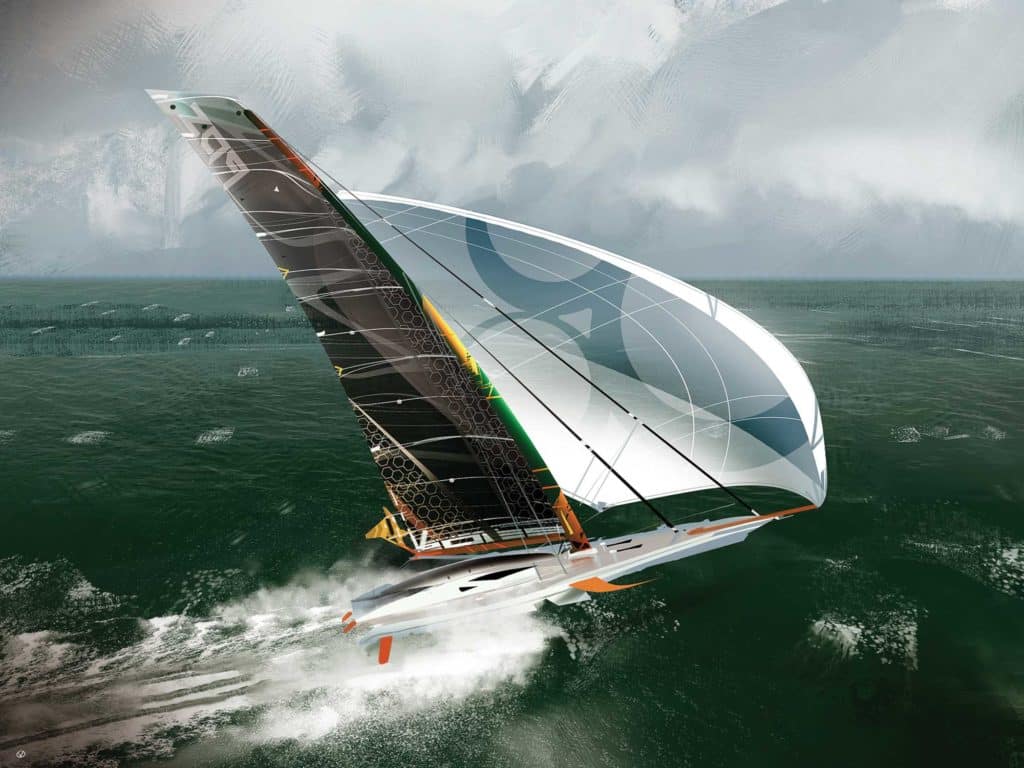
Hydrofoils have been providing dynamic lift since fish sprouted fins. And people have been employing foils ever since they first put paddle to water, and certainly since adding keels and rudders to boats. But the modern, flying America’s Cup boats, kiteboards, Moth dinghies, shorthanded offshore thoroughbreds—these are all playing in a new world in which the terms “hydrofoils” or “lifting foils” describe those oriented to raise a hull or hulls from the water. In these racing realms, if you ain’t got foils, you ain’t got nothin’.
Lifting foils that allow these boats to sometimes home in on three times the wind speed might appear to be of little interest to cruising sailors, but with such common cruising features as self-steering and autopilots, self-tailing winches, rope clutches, fin keels and faster hull shapes all having been passed down from the racing scene, one must ask, “What promise, if any, do hydrofoils hold?”
Lifted or partially lifted boat patents extend back to 1869, but workable watercraft took roots along with early flight. Italian Enrico Forlanini began experimenting with foils in 1898. In 1906, his 1-ton 60 hp foiler reached 42.5 mph. Alexander Graham Bell’s HD-4 Hydrodrome flew on Bras d’ Or Lake at 70 mph in 1919. And several sailing foiler patents began appearing in the 1950s. Notably, JG Baker’s 26-foot monohull, Monitor, flew at 30-plus mph in 1955. Baker experimented with a number of foil configurations, and at least built, if not used, the first wing mast. The first offshore foiler was likely David Keiper’s flying trimaran, Williwaw , in which he crisscrossed the Pacific in the 1960s.
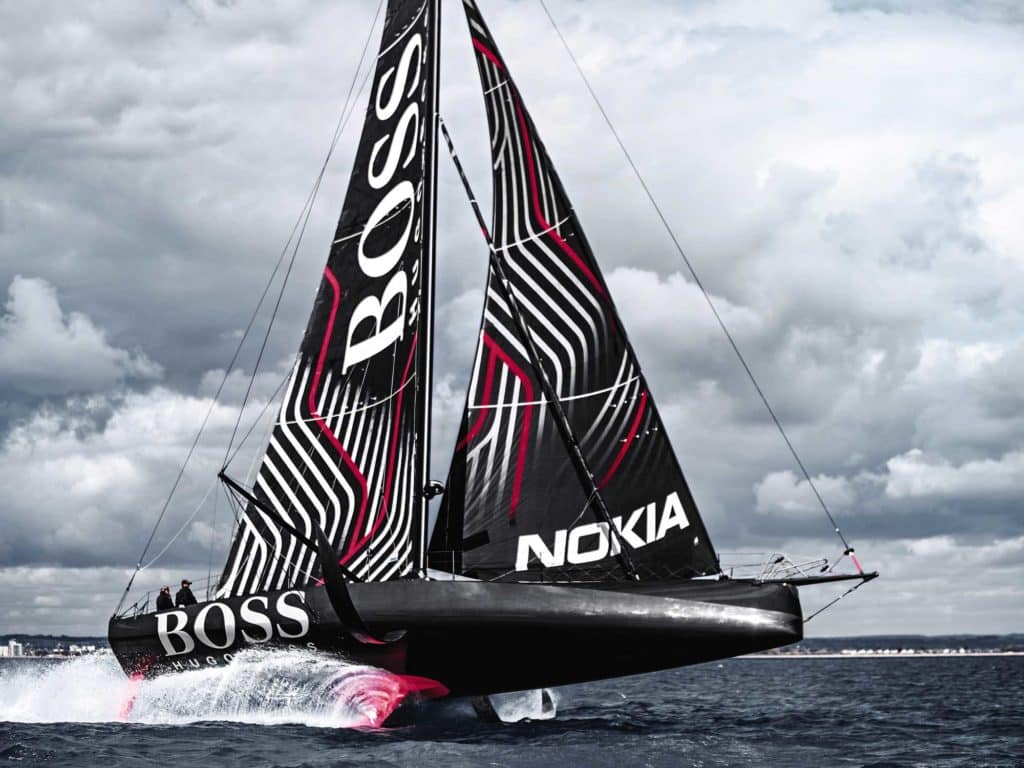
By the 1980s, numerous speed-trial and foil-enhanced offshore-racing multihulls showed huge promise, and have since evolved into behemoth trimarans clocking 30 to 40 knots continuously for long periods, not to mention the monohulls in the Vendée Globe (and soon the Ocean Race) that are capable of speeds exceeding 30 knots. But as boat designer Rodger Martin once reminded me, “If you want a new idea, look in an old book.” He was right. The fully foiling monohulls that will compete in the 2021 America’s Cup will bring things back full circle to the foiling monohull Monitor .
Fluid Dynamics Primer
Any foil—a wing, sail, keel, rudder or lifting foil—redirects the flow of fluid (air included), creating high- and low-pressure areas on opposite sides of the appendage, while developing lift perpendicular to the foil’s surface.
Advancements in foiling science is due in part to the hundreds of foil shapes that were tested, with tabulated results, by the National Advisory Committee for Aeronautics, the forerunner of the National Aeronautics and Space Administration. For the better part of a century now, aircraft and boat designers have been able to choose from a spectrum of refined foil sections that produce predictable amounts of lift and drag for known speeds of fluid and angles of attack, or the angle at which the foil passes through the fluid. Sections of efficient faster foils, as seen on jets or as we flatten our sails to go upwind or reach high speeds, have smaller nose radii and are thinner, with the thickest section of the foils farther aft, up to nearly halfway toward the trailing edge.
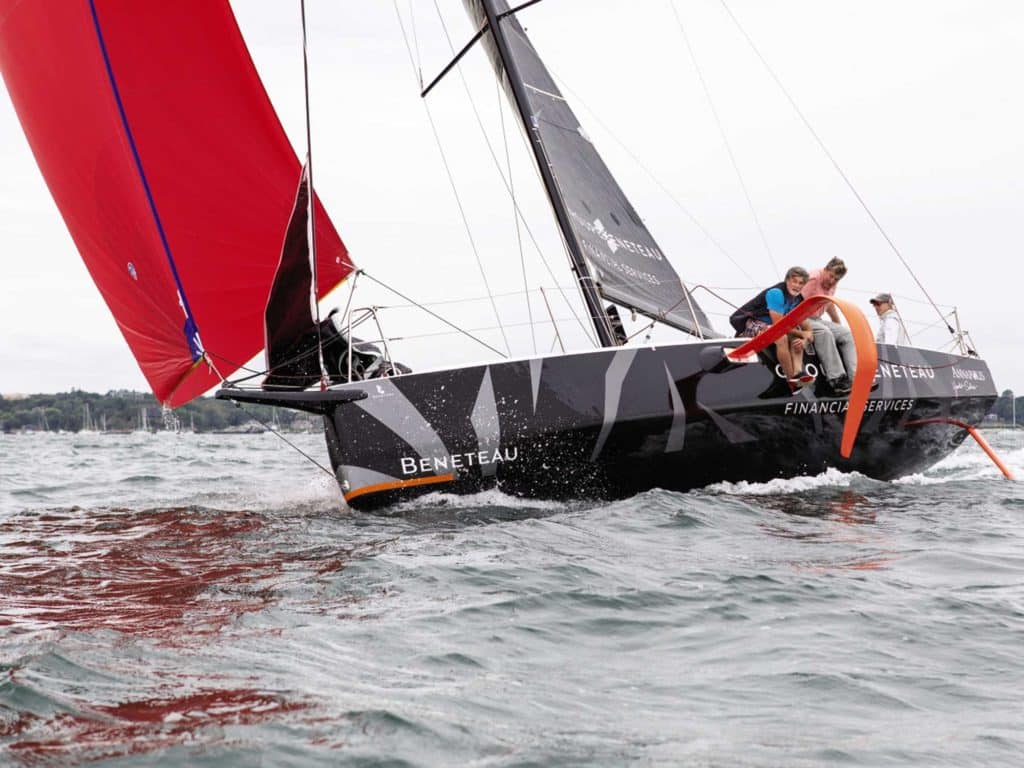
The most efficient foil sections at slow speeds are fatter, with the maximum thickness farther forward, and with larger nose radii, than faster foils. The angle to fluid flow or angle of attack also is greater. We see these slower foils on wings of prop planes and sails when off the wind or in light conditions.
Most sailors are familiar with traditional foils on boats, the teardrop sections of keels that produce lift to weather, reducing leeway, and of rudders, allowing them to steer. Even a flat plate can be a foil, but these tend to be inefficient. Such a shape is prone to fluid separation from the surface, meaning they stall easily, and they maintain poor lift-to-drag ratios. Even keels and rudders are somewhat lift-compromised because they are symmetrical and have to work with fluid coming from either side, whereas lifting foils are more like aircraft wings or propellers, with asymmetrical sections honed for performance in a more stable, fluid flow.
The point is, any foil can be employed at various angles to the surface to prevent leeway, produce increased stability, or help lift the boat out of the water. But those not required to work with fluid flowing from opposite sides can then be honed to maximize lift and minimize drag. Asymmetrical foils were used on boats like Bruce King’s bilgeboarders, including Hawkeye , back in the 1970s. And, designers, including Olin Stephens, had previously employed trim tabs behind keels to improve keel performance.
Sails, which are heeled airfoils, not only drive the boat forward, but they also produce downforce, actually increasing the dynamic displacement of the boat. To counter this and keep the boat sailing more upright, multihull designer Dick Newick first employed slanted asymmetrical hydrofoils in the outer hulls of his small charter trimaran, Lark , in 1962. A portion of the lift developed by the hydrofoil resisted leeway, while a portion worked to actually lift the leeward hull, keeping the boat more upright and reducing dynamic displacement and drag.
Anyone who has ridden on even a foil-stabilized boat will know how riding at least lightly on the waves, and especially above them, beats smashing through them. When boats lift off, everything gets a lot smoother, drag falls away, and the boat accelerates.
Cruising on Foils
But why would a cruiser want to whip over the sea? Wouldn’t this demand an inordinate amount of attention by the crew? Would lifting foils even be applicable to a boat that must have substantial displacement to carry crew and stores? Aren’t cruising-boat hydrofoils an oxymoron?
Maybe, but I believe our boats’ hulls are likely to sprout fins much as fish have as we orient foils to more efficiently resist leeway, add stability, aid steering, reduce drag, increase comfort, allow for shallower draft, and enhance wider variations in hull shapes.
Boats have gotten increasingly wide through the years to advance form stability, improve performance (primarily off the wind), and boost interior volume. But the downside is that fat boats tend to slam more upwind. What if you could reduce dynamic displacement of the boat and lift that hull even partially from the water? The result would be less slamming, especially upwind.
At the same time, what about narrower boats that are known for being more seakindly, especially when closehauled, but lack form stability to carry adequate sail area for powering upwind, and tend to roll badly downwind? Or shallow-draft vessels that are lovely for cruising, but again, tend to suffer from reduced stability? Foils can give that stability back.
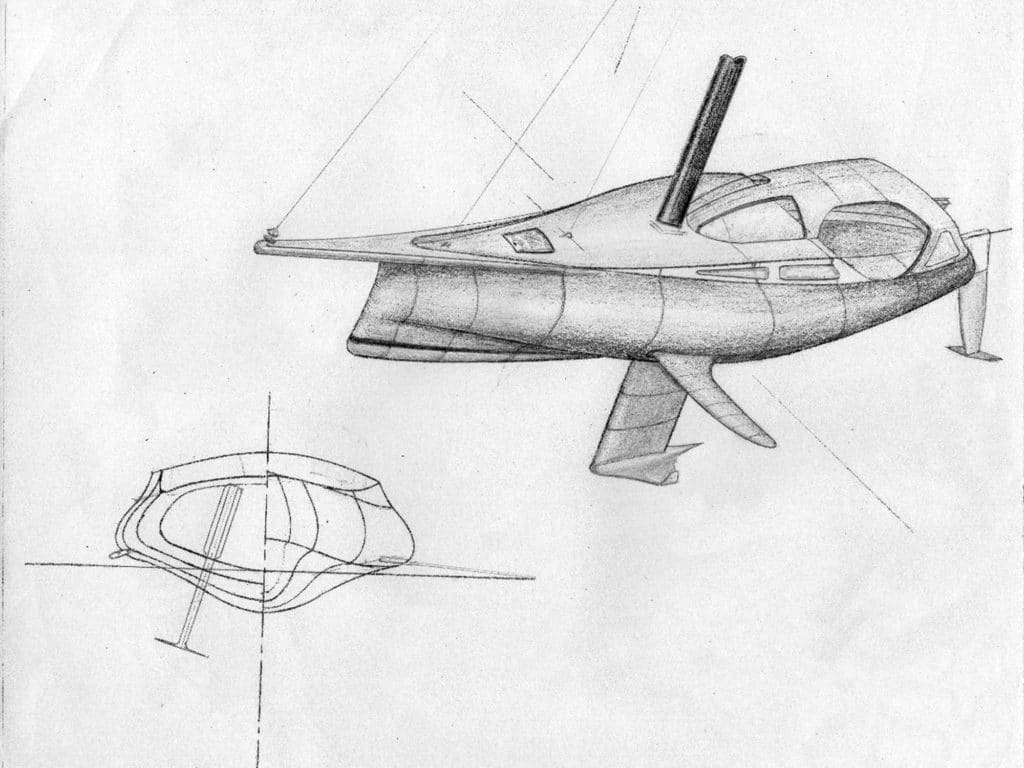
Looking ahead, boat designers might choose to reduce ballast, making up for it with a foil. In short, lifting foils can reduce boat drag and motion while increasing power and performance.
Pitching also does no favors for speed or crew comfort. Foils can come into play here as well. Foils parallel to the sea’s surface resist motion up and down, and a lifted boat skating above chop also is less prone to hobby-horsing through waves. Multihulls have always been particularly susceptible to pitching for a number of reasons, but watching videos of multihulls sailing to weather show an obvious huge advantage that foilers have compared with nonfoilers. Offshore multihulls now routinely employ T-foils on the rudders to control the fore and aft angles of the boat (attitude), a feature easily adaptable to any vessel.
OK, so what’s the cost? Obviously, the more things sticking through the hull, especially if they are retractable, the more it’s going to impact the interior. There would be added weight, complexity and cost. Foils also create noise, and there’s susceptibility to damage from hitting stuff. And let’s not forget compromises with shapes, purposes and things not yet imagined.
As for damage, it’s possible to fold the foils back into the hull. Think swinging center- boards or actual fish fins. Daggerboardlike foils can at least employ shock-absorbing systems similar to the daggerboard arrangements found in many multihulls. This includes weak links that are outside the hull, so if a foil is struck, it frees the foil to fold back or to come off before being destroyed or damaging the hull. Or, foils might hang from the deck rather than penetrating the hull, allowing them to kick up (and to be retrofitted to existing boats). These configurations also relieve the interior of intrusions, and keep the noise more removed from it. I have no doubt that numerous talented designers will be exploring all kinds of options and compromises in coming years, finding ways to make foils both practical and more than worth the compromises.
Sailing more upright, shallower draft, speed, comfort—what’s not to like? Just what is possible? I have a feeling the cruising community is about to find out.
Steven Callahan is a multihull aficionado, boat designer and the author of Adrift , an account of his 76 days spent in a life raft across the Atlantic.
- More: foils , How To , hydrofoils , print june july 2020 , sailboat design
- More How To

3 Clutch Sails For Peak Performance

It’s Time to Rethink Your Ditch Kit

8 Ways to Prevent Seasickness

How To De-Winterize Your Diesel Engine

Kirsten Neuschäfer Receives CCA Blue Water Medal

2024 Regata del Sol al Sol Registration Closing Soon

US Sailing Honors Bob Johnstone

Bitter End Expands Watersports Program
- Digital Edition
- Customer Service
- Privacy Policy
- Email Newsletters
- Cruising World
- Sailing World
- Salt Water Sportsman
- Sport Fishing
- Wakeboarding

Kitesurfpro.nl
Home » Kitefoiling » Syroco – Fastest sailboat with 150 km/h with kite and foil
Syroco – Fastest sailboat with 150 km/h with kite and foil
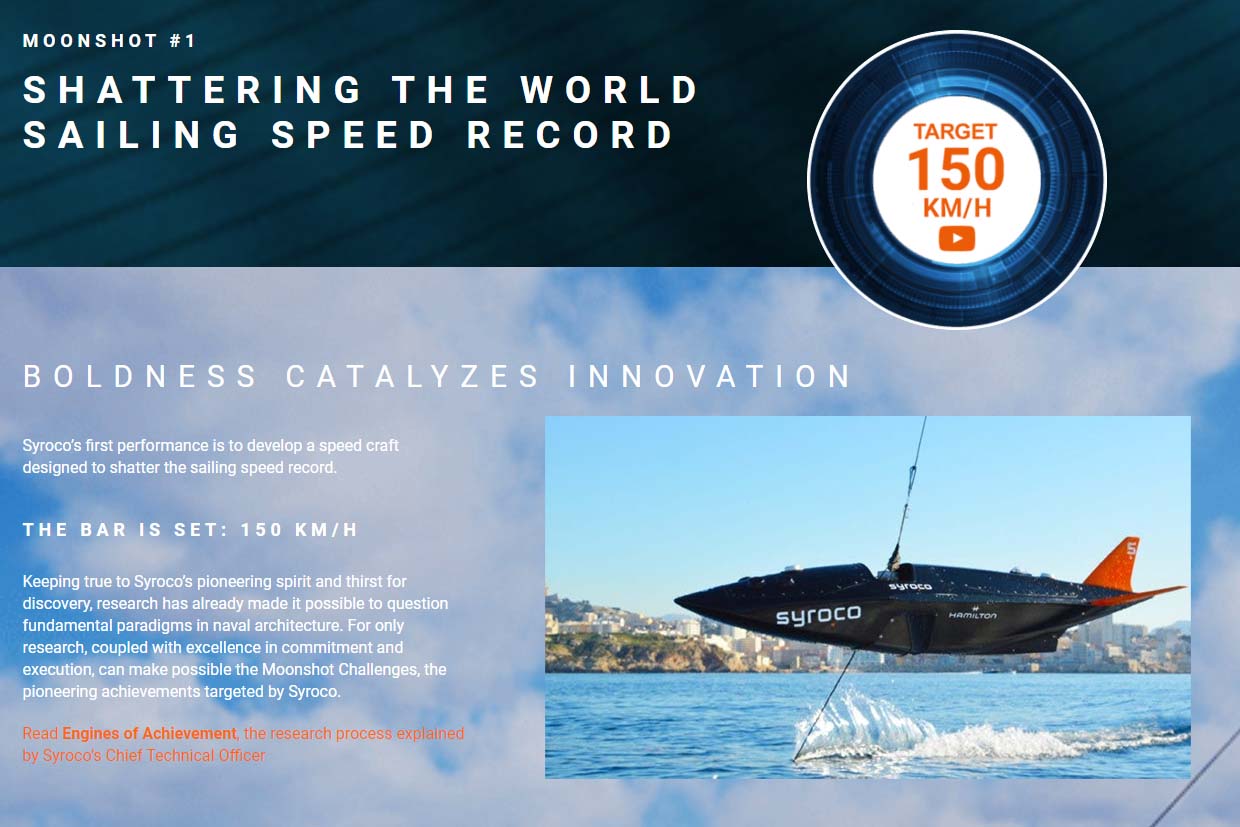
Did you know that the French startup Syroco lab is working on the fastest sailboat of all time. It should happen in 2022: a wind-powered boat has to break the speed barrier of 150 kilometers per hour. We explain how the team led by Alex Caizergues, 4 times champion kite speed , with a six-meter-long fish-shaped capsule that is pulled by a kite that wants to go over the water at 150 kilometers per hour.
Fastest sailboat in the world: 121 km/h
As of 2012 it is world speed record sailing remained unbroken. Because in November 2012, the Australian Paul Larsen reached 65,45 knots, a speed of 121 kilometers per hour. This is what he achieved with his Vestas Sail Rocket 2 when he blasted over the South Atlantic waters off the coast of Namibia. There are currently two rival teams looking to go above and beyond and build the fastest sailboat, or maybe kitefoil boat, in the world.
Syroco Moonshoot 1 facts
Origin fastest sailboat in sahara.
First of all, the name Syroco was deliberately chosen for the project. He probably appeals to sailors who have sailed in the Mediterranean. The Siroco is a warm savage southeastern wind that originates in the sandy plains of the Sahara desert. That is why Caizergues named his project after it.
Syroco - Sailboat but not as you think
Even though there is talk of sailing records, you have to forget the traditional sailboat concept for a while. Precisely because the Syroco can best be described as a six meter long fish-shaped capsule that is pulled by a kite.
We immediately had to think of how kitesurfing olympic could be. You remember sailing.
Other than kitefoiling
However, the fish-shaped capsule hangs above the water. Under the water, the angled hydrofoil should do the job. The wing of the foil and the mast are the only points of contact with the water at speed. From kitesurfing we see that kitesurfing brand F-one is an official supplier for the Syroco Moonlight 1.
'Weightless hunting' concept
As you can see in the video, the operation of the hydrofoil is different than we know with kite foiling and wing foiling. The Syroco foil provides counter pressure to the kite. In between hangs the yacht, which thus becomes weightless.
It's all about optimal aerodynamic and hydrodynamic distribution of opposing forces.
Test run passed
In December 2021, numerous test runs were carried out with the prototype of the Syroco Moonshoot 1. These were ultimately successful. At high speed, the Syroco came out of the water via a cable that simulated a kite to sail on the foils. look at it test runs report .
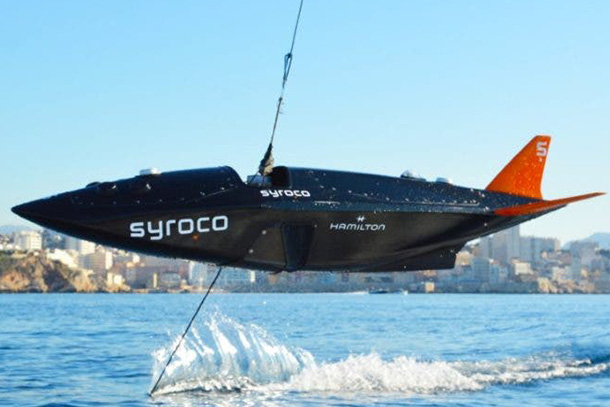
Keep control at 150 km / h
Two people go into the capsule who have to keep things in line. The kite must be controlled. The balance on the foil must also be found. And then again as optimal as possible in strong wind. Who to kitefoiling , wingfoiling or sail foiling, know that this is not easy.
The race is ambitious and will hopefully bring about breakthroughs
We know by now: set an impossible goal and work on it until it becomes possible. This is what helps companies like Apple and Tesla push the boundaries of technology. In fact, this is also Alex Caizergues' approach with Syroco. He wants to push boundaries and thus, as a channelizer for the maritime sector, realize new technologies and more efficient ways.
Formula 1 on the water in the future?
Another, hitherto speculative, line of thought is whether this project could develop into a new sport. A kind of Formula 1 on the water.
We follow the Syroco project closely. For now, take a look at how Alex Caizergues goes with kite surfing: 107,36 kilometers per hour.
Bonjour, j'ai découvert votre projet en regardant un JT en Nouvelle-Calédonie. Je ne pratique pas le kite (j'ai un peu pratiqué le parapente et très longtemps avant, l'avion CESSNA), but comprends certains principles. Si vous visez les 150 km/h, vous vous confrontez à un problème d'envol, donc de perte d'adhérence sur l'eau et comme ils n'ont pas des commandes de stabilization du monde aérien, le pilote perd le contrôle, il ne maîtrise pas la transition et n'a pas les commandes pour voler). Vous aurez surement ce problème selon comment souffle le vent, la manière d'orienter votre voile et la direction prize. And kite, in general, the picture is parallel to the kite surfer's plan. Sur les vidéos de Syroco Moonlight 1, votre voile est orientée perpendicularement à votre “bateau-coque de 6 mètres”, soit dans le sens d'un parapente allant en avant (qui peut être ascendant ou descendant selon la tenue des risers en extrémité de voile).
Je ne sais pas à quelle hauteur vous allez décoller si cela arrive, mais les chutes peuvent être violentes (au pire 20 mètres par sec) et entrainer de la casse. Je ne sais pas comment vous vous protégez en cas d'incident.
Autrement, même si la probabilité semble faible, la vitesse visée et votre foil dans l'eau risque de rencontrer des morceaux de bois, des animaux (qui seront blesser ou tuer), des filets… Don't forget to take the time to enjoy the food, enjoy the life of the flottants, the animals, the fillets.
Problem vous allez migrez vers un système “hydravion” avec des commandes avions pour le contrôle.
On the internet, on the basis of the décollage speeds: “Quelle vitesse pour faire decoller un avion? L'ordre de grandeur de la vitesse de décollage est de : 20 to 50 km/h pour les planeurs ultra-légers motorisés (ULM). 80 to 120 km/h pour les avions monomoteurs de loisir ou les bimoteurs à hélices d'affaire. 240 to 280 km/h pour les avions de ligne selon leur taille (A320, A380).”
Good continuation, Lauren HELLOUIN. ([email protected] et +687 815149)
Give a reaction cancel reply
The email address will not be published. Required fields are marked with *
Save my name, email on this site for the next time.
Related blogs and comments
Competition calendar dutch championships kite surfing update.

How much wind is needed for kitesurfing? Kiting options with 10 knots
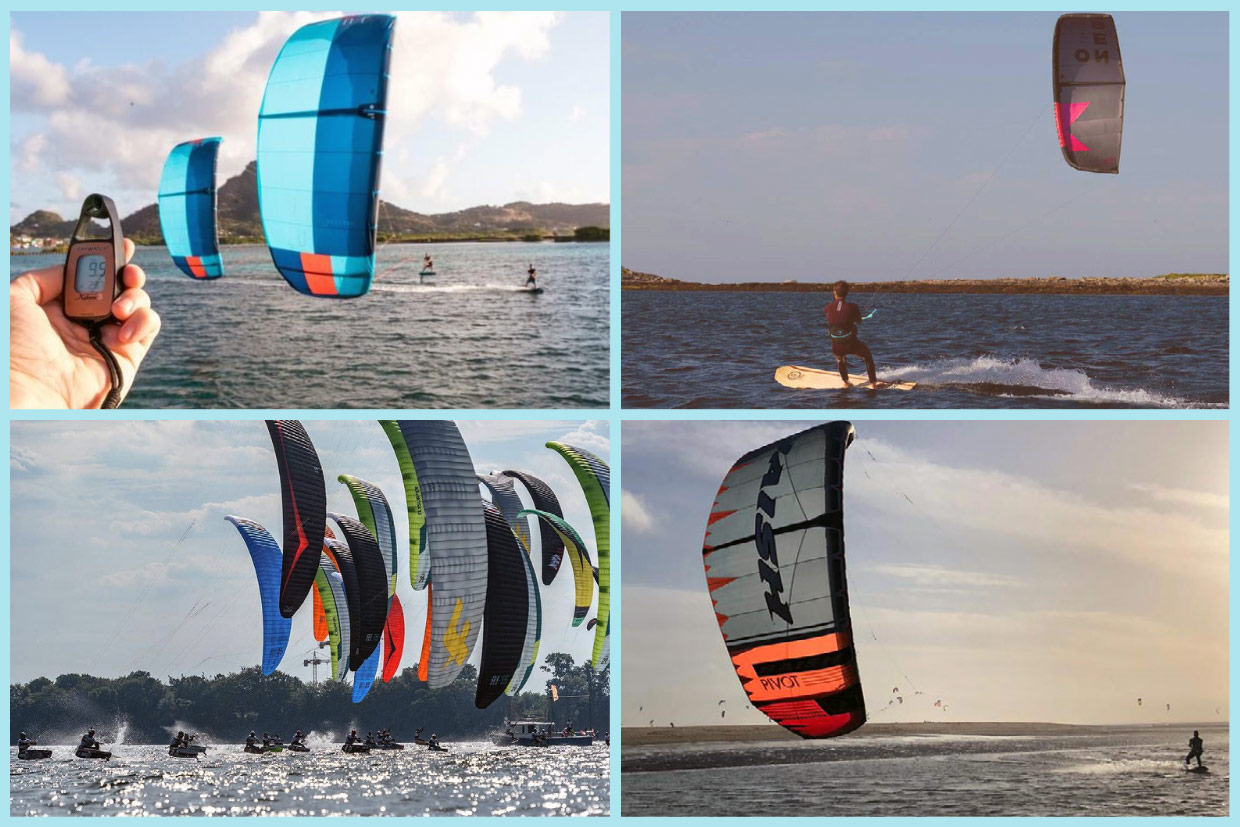
On the way to Olympic kitesurfing Paris 2024
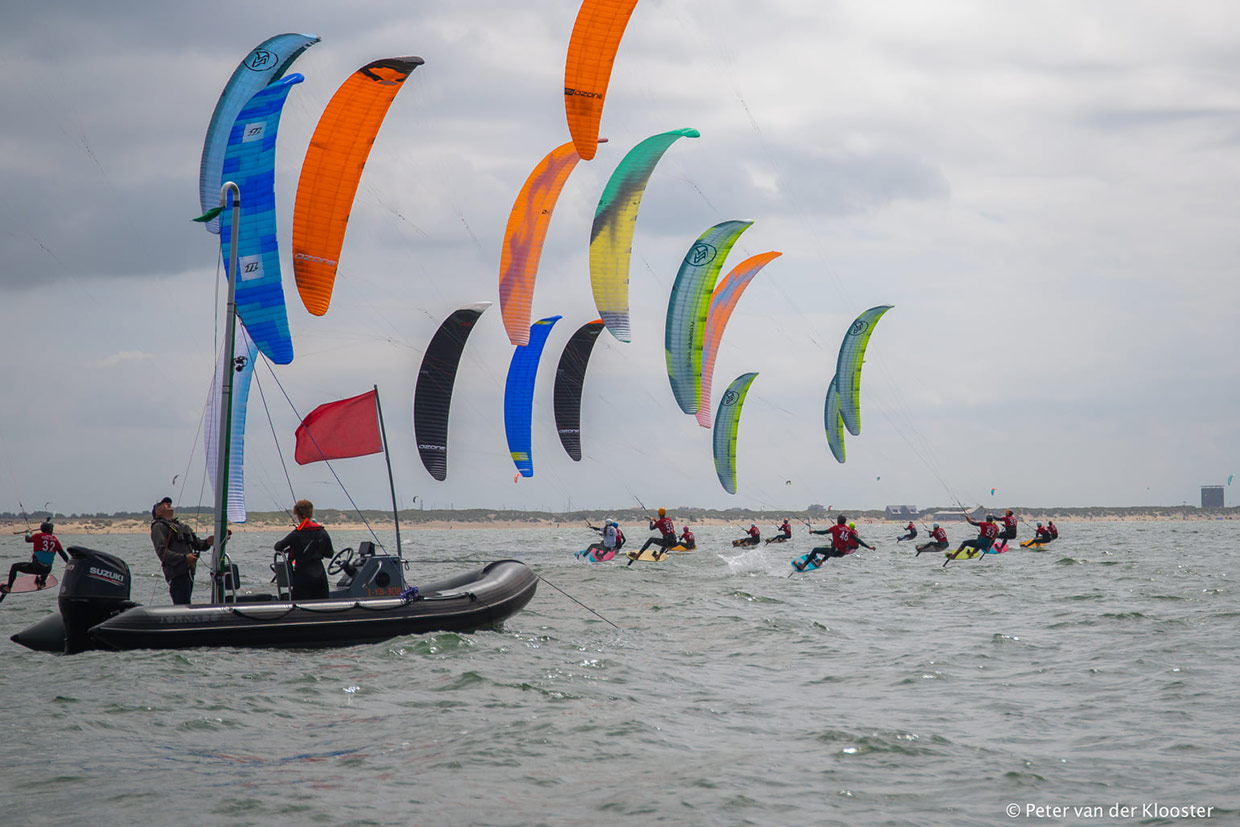

- FlySafe ® Foil Control
- iFLY Reviews
- Our Partners
- Distributors
Class Association
Enter your keyword.
Just enjoy high speed - foiling
” iFLY – Born to FLY “
Just enjoy foiling, ” high performance sailing “, ” we love speed “, ” join the adventure “.

iFLY15 – Technical SPECS
Length 4.63 m, 15 ft..
A Foiling Catamaran for 1-2 person(s) does not need to be any longer than this. The ancient rule that says you need length to achieve speed does not apply, as hulls do not touch the water at most times.
Width 2.50 m.
This width provides plenty of righting moment, still being road legal ato be transported in horizontal position without disassembly.
7.5 m mast / 11.2 sqm mainsail
7.5 m mast with 11.2 sqm deck-sweeper mainsail. – 8.5 m mast on iFLY RAZZOR Pro with bigger rig
Draft: 95 cm
Weight: 90 kg.
90 kg ready to sail. A very light boat, providing nonetheless excellent stability for everyday suitability.
Crew 1-2 - max.180kg
Flysafe® foil control.
T-Foils Main Foils and Rudders FlySafe automatic dynamic foil control Additional Option: Main Foil Differential >>>
Know More >>>
Different - Rig Options
LATEST DEVELOPMENT OF “DECK SWEEPING” MAINSAIL THE ROLLABLE HERU WING RIG LIGHT WIND FORESAIL «CodeF»
Full Carbon Hulls
Looking for the perfect setup for your foiling sailboat.
We can recommend the best iFLY setup and accessories for your boat. Get in touch for the ultimate sailing experience!
Performance
A great number of innovations all over the catamaran and the perfect match of all components allow controlled high-speed foiling experience. iFLY15 is full of innovations, e.g. in hull design, hydrofoils, rudders, automatic flight control system, two-layer wing trampoline, high performance rig…
HULL Design
full carbon – lightweight – performance design: Born to foil
High Performance Rig Options
LATEST DEVELOPMENT OF “DECK SWEEPING” MAINSAIL WORLD PREMIERE: THE ROLLABLE HERU WING RIG : WORLD PREMIERE: LIGHT WIND FORESAIL «CodeF». ALLOWS UPWIND FOILING (as well as other courses/points) ALREADY IN EXTREMELY LIGHT BREEZE. Know More >>>
Two Layer Trampoline
AERODYNAMIC INNOVATIVE WING TRAMPOLINE CREATING LIFT.
Full Carbon T-Foils
SCIENTIFICALLY DEVELOPED high-end foils for early take off, high speed and maximum stability.
flySafe® dynamic foil control system
The foils are controlled independently, dynamically and precisely on both sides by the flySafe® foil control system . This enables high performance sailing through stable flight. The unique foil control system of IFLY15 is a 7 years proven system developed by CEC Catamarans. Know More >>>
IFLY MAIN FOIL DIFFERENTIAL TECHNOLOGY
MDT FOIL CONTROL – iFLY rake control The sophisticated main foil differential is an active flight assistance – The Rake is adjustable while sailing. Advanced Rake Control is for the experienced, performance-oriented Catamaran sailors / pro sailors and is a feature on the iFLY RAZZOR Pro. Know More >>>
Innovations and more >>>
In the hand of the experienced sailor, iFLY15 is a high-performance racing machine. STABILITY IS NOT CONTRADICTORY TO HIGH PERFORMANCE OR SPORTINESS , on the contrary, it is a prerequisite for safe reaching and maintaining constant high speeds. Stable flight allows the sailor to concentrate on the course, on the wind, as well as on opponents and strategy – rather than permanently getting distracted by working on the foiling balance.
EARLY TAKE OFF IN WINDS AS LOW AS 2Bft. / 6 KNOTS , by combining the innovative “KickOff” foil control with a trampoline that provides boost and with the latest generation of rig and foils.
BOAT SPEEDS FAR BEYOND DOUBLE WIND SPEED CAN BE ACHIEVED . Enjoy high speed foiling with top speeds far beyond 25 knots – in ideal conditions up to 30 knots.
CONTROLLED FOILING EVEN IN THE UPPER WIND RANGE BEYOND 22KNOTS OF WIND SPEED – supported by the new FlySafe® Automatic Foil System.
FOILING PLEASURE AND PERFORMANCE ALSO IN CHOPPY WATERS
FREEDOM ! FLYING SOLO OR OPTIONAL WITH CREW . You have the choice. No manhunt for crew. But still enjoy the opportunity of taking a friend or family to fly with you. Up to 140kg of crew weight. (To keep the boat and especially the mast light, we specified the iFLY15 components intentionally not for double trapeze.)
NO HOISTING AND LOWERING OF DAGGERBOARDS while sailing. (Only for beaching or in shallow waters.)
FREEDOM TO SWITCH BETWEEN FLYING MODE OR SAILING AS A CONVENTIONAL CATAMARAN (with at least the leeward hull touching the water). Within seconds iFLY15 can be switched to Non-Flight mode, even while sailing. In that mode, iFLY15 will not take off, but the foils will still create lift and give an extra agile sailing behavior, which is on the same time very stable as rudder Foils will avoid pitch poling. Non-Flight mode is providing additional security in extreme high wind speeds. It is also useful for less experienced sailors or in all situations, where taking off is undesirable (e.g. in the harbor or while towing…).
EASY TO LEARN FLYING BY AVERAGE SKILLED AND TRAINED SAILORS
EASY BEACHING AND SLIPPING , as simple as with any conventional beach catamaran by using a standard catamaran beach trolley. Foils remain flat under the keel, with the daggerboard lifted as on a conventional catamaran.
SIMPLE TO DISASSEMBLE PLATFORM . Width of 2.50m is also road legal in most countries for horizontal transport without disassembly.
DAGGERBOARDS CAN BE PLUGGED IN FROM ABOVE and Foils securely anchored from below with one central screw.
FAST SET-UP OF THE iFLY15 FROM ROAD TRAILER TO SAILING . Simple rigging the mast, no genacker boom, no foresail, no spi.
SILENT AND CALM PLANING ABOVE THE WAVES . Flight height of up to 90cm, avoiding even high waves below.
EASY TO FOIL THE JIBE (without landing). Stable maneuvers are made easier by the fact that the four T-Foils always remain in the water.
« INTERNATIONAL FORMULA 15 FOIL » Class Association. The new development class for FOILING, SINGLE HANDED on MULTIHULLS. Multi manufacturer class in the tradition of a Formula18, A-Class or international Moth. Enables large regatta fields and evolution of the boats, following the technical progress (which is especially essential in the case in Foiling). Strict regulations to avoid uncontrolled exaggerated development.
Contact : [email protected]
Catamaran Europe Central
The iflysail team, is looking forward to your message, more to know about ifly foiling , interesting tech, high performance rig options >>>, flysafe® dynamic foil control system >>>, ifly main foil differential technology >>>.
MDT FOIL CONTROL – iFLY rake control
News and More
Ifly foiling experience >>>, press articles >>>, events >>>.
NORTH AMERICA'S LARGEST AND MOST ADVANCED DINGHY FACTORY
Country/region
- Australia AUD $
- Austria EUR €
- Belgium EUR €
- Canada CAD $
- Czechia CZK Kč
- Denmark DKK kr.
- Finland EUR €
- France EUR €
- Germany EUR €
- Hong Kong SAR HKD $
- Ireland EUR €
- Israel ILS ₪
- Italy EUR €
- Japan JPY ¥
- Malaysia MYR RM
- Netherlands EUR €
- New Zealand NZD $
- Norway USD $
- Poland PLN zł
- Portugal EUR €
- Singapore SGD $
- South Korea KRW ₩
- Spain EUR €
- Sweden SEK kr
- Switzerland CHF CHF
- United Arab Emirates AED د.إ
- United Kingdom GBP £
- United States USD $

Item added to your cart

fulcrumspeedworks
*NOTE: Sales team will contact you with shipping rates.

WHAT IS IT?
The UFO is a simplistic modern hydrofoiling boat, that allows anyone to fly through the air, freeing the hull from draggy water. More stable than the International Moth -or even a child’s pram- with a simple rig, and a set of fully retractable hydrofoils, all for $11,500 USD the UFO makes flying attainable. Thousands less than it’s nearest competition. Built in the United States in high volume and quality control, the UFO maintains a one-design philosophy, creating close and exciting racing on foils!
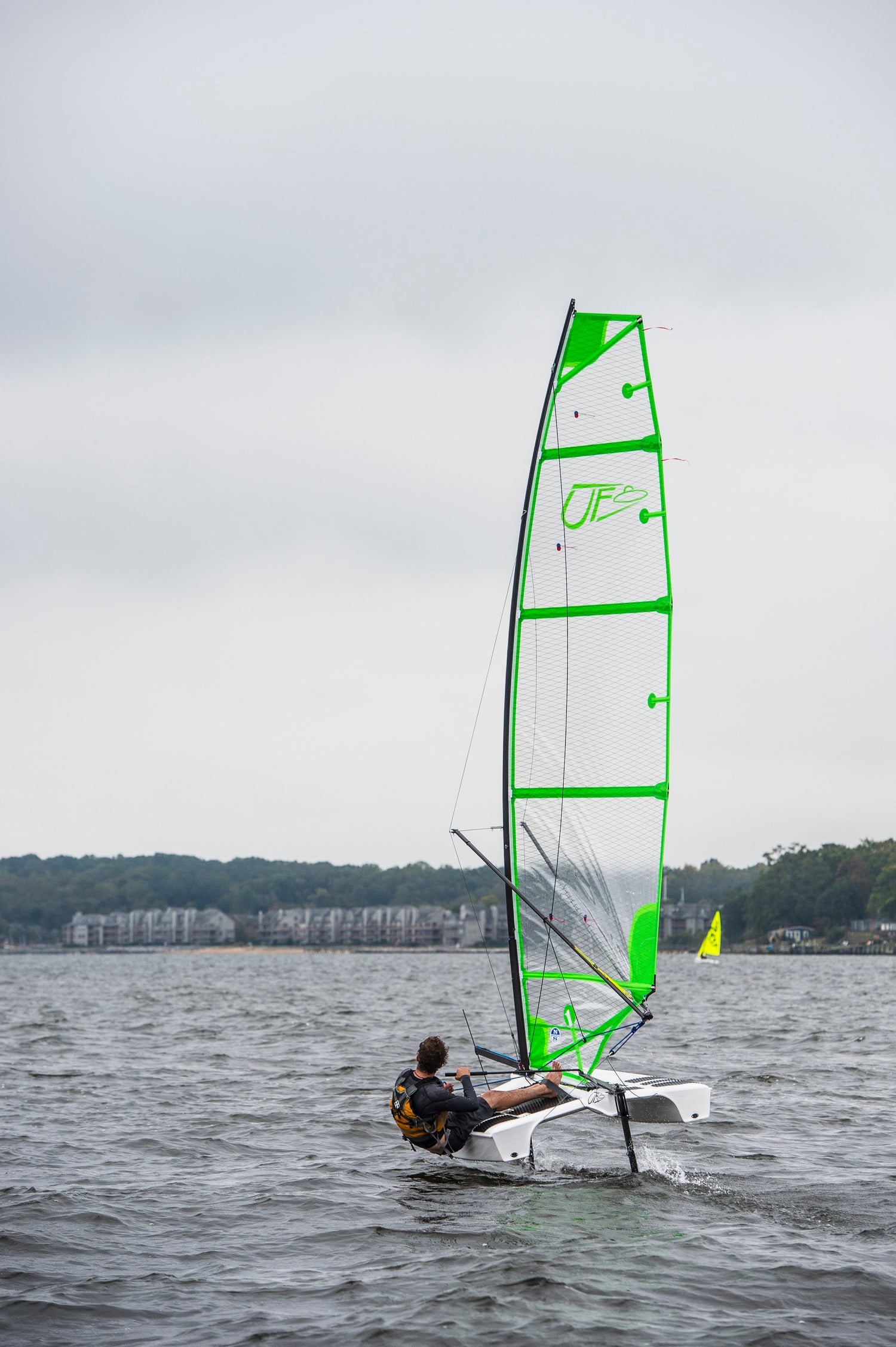
FLY WITH THE UFO
- Designed and built in the USA
- $11,500 USD
- Compatible and rewarding to all skill levels
- Lightweight for easy maneuverability
- Solid, nearly dent-proof, hull
- Unique patented hull and rig designs
- Stable on and above the water
- Small footprint for carefree storage and shipping
- Takeoff from about 8knts of wind
- Fast, fun, easy to control foiling

FUN FOR ALL AGES
The wand system controlling the foils, which can be set to fly very high, very low (even ‘no fly mode’) and all points in between. This means you can progressively add challenges to your UFO experience as you feel ready for them, from ‘beginner mode’ all the way to ‘extreme mode’. Additionally, the highly tunable sail can be set up to provide only the amount of power that your body type needs, and no excess. This means that the UFO is accessible and fun for sailors of all sizes, ages and skill levels. Merely set up the boat for your skill level and body type and go play around.
The UFO is very broadly applicable and has flown payloads from 70 pounds -a tiny kid- to 270 pounds -a tall grown man and a teenage boy-. The foil package just needs power to climb. Ultra light sailors have been caught on camera flying in 5 knots of breeze and the baseline for 225 pound sailors to take off is 10 knots. 270 flies in 12 knots of breeze.
SETUP AND BREAKDOWN
While the boat can be left on shore with everything in place, but the sail down, that doesn’t mean the UFO isn’t easy to put together or take apart. Quite the opposite. Simplicity begets simplicity and the boat is a cinch to put together and take apart.
MANAGEABILITY
Being small is it’s own reward when it comes to handling the boat through all sailing experiences. When you start to really push yourself learning to foil, there are good odds you’ll manage to capsize it. The UFO is easy to right from capsizes and even full “turtle” inversions. This last part is critical, because when catamarans are too heavy to right from turtle the only option is to make the mast float. This has the unintended downside of making the boat very likely to blow away from you. The UFO is designed to stay right alongside you in the event you are separated from the boat. Additionally, the boat possesses an uncommon “park” mode in which it will hold station of its own accord, apparently indefinitely without external input of any kind. The full benefits of that upside have not begun to be fully exploited.

FOILING AT ALL POINT OF SAIL
The Fulcrum design team strictly adhered to the axion “if there’s a point of sail (say, upwind or downwind) that it can’t always foil on, you can’t call it a foiler”. The design team achieved their goal and the UFO is a fully flying boat on all points of sail, which drastically increases its fun-factor.
At what points of sail does the UFO foil at?
The UFO fully foils at all points of sail. Upwind, downwind and reaching. Additionally, you can set it to not foil when you’re tired and it will do that as well, so you can get home easily. These two factors make the UFO uniquely good for learning to foil.
Who can fly the UFO?
Within reason, anyone.
UFO pilots have ranged from 8 years old to 72, from 90 pounds to 235. Young sailors do well sailing as pairs or with a middleweight to light adult. It’s rare that anyone on the fulcrum team conceives of a boat with a narrow niche in mind. Why bother? It’s a mistake in yacht design to design a boat for a narrow range of users, when for the most part people are diverse and the objective of one-design boats is to garner large fleets. That said, the boat is likely to be most satisfactory in all wind conditions in the hands of teens, small and medium men and all women. At the extreme low end of the weight range, sailors may find themselves overpowered and at the extreme high end, the wind speed required for takeoff is about two knots higher than average. UFOs have been sailed “two up” as well, though the above limits of weight range still apply to the sum of the two sailors weights.
What wind and waves can I fly a UFO in?
The UFO will sail in practically any wind condition. However, it’s important to remember that with all sailboats there are days that are great to sail in and days where you do something else.
While the UFO can at times with a skilled skipper take off in very low wind speeds, the baseline for reliable flight is around eight knots. Trying to squeeze enough power to fly out of too little wind is tiresome and in those circumstances, it’s best to do something else. In 8 knots and above, flying is magical and unforgettable. In under 8 knots, the UFO reverts to being a pleasant displacement catamaran and goes from being exciting and fast to relaxing and tactical. This is another benefit of being a catamaran.
Over the last six years the UFO has proven to be uniquely good at flying safely and consistently in very high windspeeds. In multi-class foiling regattas the UFO has proven to be the only foiler built to date that simply loves high windspeeds. In winds above 22 knots when other foiling boats make for shore, the UFO wants to keep playing. The upper wind limit is more a matter of taste and skill. UFOs have been sailed in 36 knots, but that requires a great deal of skill and focus. The UFO rig having shared DNA with a windsurf rig seems to play a part in the boat’s remarkable ability to get a kick out of big wind. Since the upper wind limit on the UFO is so much higher, this makes the number of optimal days to fly a UFO (if skilled in sailing one) higher per year than with any other production foiling boat.
Most chop and wave conditions present no issue for a UFO set for the days’ conditions. After all, powered hydrofoils were first developed by various leading Navy’s as a means of smoothly flying over challenging sea-states. Choking up the ride height helps the UFO fly smoothly through the bottom of the wave pattern, undeterred. Rolling seas present even less issue, as the UFO will ride along them just like any other. Extremely tight and tall chop can be very annoying, which is not peculiar to the UFO.
Waves do effect baseline windspeeds to achieve takeoff. Imagine getting a plane to take off on a bumpy runway. This is true for all hydrofoil boats. In choppy water, ten to twelve knots can be necessary to achieve fully easy takeoffs. Some UFO sailors use aggressive kinetic techniques to overcome this and take off in choppy water and low wind.
Will I fly my first time out?
Most people do, but bear in mind that flying is a whole new experience and it takes some learning.
Conditions, setup and technique matter and if you use it incorrectly, you are likely to get some degree of incorrect results. That’s the challenge that the UFO is built to address. Over six years on the market and over 500 boats delivered, the UFO has proven to be the best and most reliable platform for ordinary sailors to reliably teach themselves foiling technique on.
What happens when I crash my UFO into something?
You’ll probably do some damage to it.
The UFO is built with durability as a core objective but it’s worth noting that the gulf between “Feather light under engineered ragged-edge high performance craft” and “literally indestructible” is extremely wide. The UFO represents neither of these extremes. Do not attempt your first flight inside a densely packed mooring field. Obstacles only make you better once you’ve mastered the basics.
How easy is it to rig a UFO?
Best in class, vs other foiling boats on the market. With that said, it’s not easier than doing nothing. Doing nothing is very easy! Putting a boat together is worthwhile but obviously involves effort.
The current cartop to launched speed record is roughly 15 minutes. Socket the mast together. Attach the boom and stays in one go. Step the rig. Flip the boat on its side, insert the foils, right the boat, hoist the sail and launch. Complexity is best avoided.
Leaving the UFO on a dock or a beach with the rig in and the foils simply in the “up” position, achieves an ease of daily use on par with any light beach cat. To go foiling all you need to do is hoist the sail with the halyard, clip the sail to the boom and attach the downhaul line and you’re ready to launch. This brings setup and breakdown to a matter of five minutes or less.
How do I launch and land a UFO?
Far far far more easily than any other foiling boat on the market.
Because the UFO is a very small catamaran, while floating the hulls float relatively deep in the water and create lateral resistance, like the hulls on a hobie 16 or hobie wave. This means that it can sail upwind without a daggerboard of any kind in the water. This is not the case with non-catamaran foilers. The rudder is outfitted with a friction brake and a down-halyard to allow its depth to vary and allow steering in shallow water. So from 16 inches of water and beyond, you can sail away from and back to shore reliably.
Because the UFO’s forward foil assembly is located in front of the mast, the UFO can tack and gybe while the forward foil is fully withdrawn from the water. This is unique. It allows the UFO to navigate reliably in the period between launching or landing and flying. The benefits for usability and safety cannot be overstated.
Once you’ve got to deep enough water, lower your foils fully and fly away!
That’s if you’re using a dolly.
If you aren’t using a dolly, the UFO has even more party tricks to show off. Since the foils withdraw to above the waterline of the hull, the hull can be beached or slid up onto a dock float or boat deck without any risk to damaging the foils. The UFO is a boat that’s eager to go sailing.
Can I easily cartop a UFO?
At this hull weight, the boat is very easy to put on top of a car, and its flat bottoms allow it to be strapped down hard with no drama. The other components of the boat collapse down to the point of easily fitting in a standard hatchback.
Where can I store my UFO?
Anywhere you can carry it to. Anywhere it fits.
Behind couches, under beds, under porches, in basements, inside larger boats, chained to apartment fire escapes, hanging in garages. Anywhere it can go that’s convenient for your lifestyle is a good place for it to go.
Why does X look like Y? Surely it would be better to make it like Z.
Just trust us.
If you’ve thought of it, we’ve weighed the pros and cons and its been included or excluded for good reason. Creating a boat that can be produced at an affordable price, for a wide range of sailors with a maximum quantity of accessible performance is an extremely hard target to hit. The UFO meets all of its objectives and does so by blatantly ignoring a few conventions and norms. You simply don’t make an omelet without breaking eggs.
- Choosing a selection results in a full page refresh.
- Opens in a new window.
Fynn Goat, one of Australia's best young kite surfers, is getting on board the wing foil
Fynn Goat, 12, is a precocious kitesurfer and wing foiler living in Darwin, where at this time of year, not fussed by crocs and jellyfish swimming in the warm waters, he can get some nice waves during the tropical monsoon season.
"We can go pretty fast on the kite," he says.
"The highest I've ever jumped is 9.5, but I say its 10 metres. Regularly I jump about 7 metres."
Out on his board he does tricks called "back rolls" and "kite loops" and he's also learning how to do "upwind tacks".
"And I'm trying and get a little bit faster on the actual foil, but it's 100 per cent just a big learning curve that I'm eventually going to get," he says.
"It will take a long time but it will be worth it."
Foiling is a kind of hybrid of kitesurfing, windsurfing and surfing.
It's a sport growing in popularity, involving a board, a hydrofoil that propels the board out of the water when it is going at speed, and a wing, which looks like a sail, that the wing foiler holds to generate pace.
By late last year, Australian Sailing, the country's sailing administrator, had declared a talent search for the best young Aussie wing foilers.
The wing foil, wrote Australian Sailing in November, is "fast becoming one of the most sought-after water sports across the globe and has started to make inroads on the racing scene".
With talk the sport could be introduced for the 2028 LA Olympics, Australian Sailing set up the "NextGen" foil program, for which young Fynn's talents were scouted.
"Olympics 100 per cent is a dream," says Fynn, who has been travelling down to Brisbane every four to six weeks this year to be part of the new wing foil academy.
"Getting there would be a big effort. I'm going to have to do a lot of comps ... It's going to be an awesome atmosphere with all the new upcoming juniors."
All the travel can be "a bit exhausting", Fynn says, but he's loving the exposure to new coaching and getting to hang out with other young foilers he's meeting in the program.
"It's 100 per cent worth it all the time. You go there not knowing one thing and then when you come back you know five more things," he says.
While balancing school with his travel, Fynn is still doing plenty of kitesurfing (he's one of the best air and freestyle kite surfers for his age in the country) while exploring his skills on the wing foil.
"I haven't specifically changed from kiting to winging, it's just a new category that's coming on and there's a big future in it," he says.
"It would be an awesome dream representing Australia," he says, while also acknowledging his Northern Territory roots.
"Even just representing the NT, because people don't think we have many opportunities here, but we 100 per cent do and there's people that go into events thinking that they are going to get smashed but they actually prove a point."
Fynn also wants to dispel the notion that it's too dangerous to get in the water around Darwin during the tropical wet season, where onlookers are often unnerved to see people swimming due to the threats of saltwater crocodiles and box jellyfish, the latter being often cited as the most venomous animal in the world.
"I'm not really that scared of crocs and jellyfish in the water, because I know that it's monitored regularly with the rangers going out and seeing if there's any crocs, but it's definitely a risk that you have to take but you always just protect yourself," he says.
"We always talk to each other if we ever see one of anything.
"We protect ourselves and for the jellyfish we put a stinger suit on – that's basically a full-body rashy, but it's mainly just important to protect all the organs in the chest."
Alanna Field, Fynn's coach, sees the potential both in Fynn and the sport.
"Wing foiling is huge overseas, and especially in Europe. Australia is jumping on board at the momentum, and that's why this next gen program started," she says.
"They're thinking that it will be a future Olympic sport, so we're just preparing now to start finding emerging athletes than can be on the pathway to join the Olympic team in the future.
Field says Fynn was selected for specialised coaching because of his kite surfing ability and competition results, as well as flashing traits that suggested he'd adapt quickly to the wing foil.
"He's got heaps of passion, lots of dedication and is really working hard at it now at such a young age," she says.
For now, flying high and fast across the sea in the Beagle Gulf, in waters most people in town want nothing to do with, it's not feeling like hard work for Fynn.
"The best thing about kite surfing and wing foiling is there's so much freedom and opportunity you can have," he says.
"I just love the freedom of it."
- X (formerly Twitter)
- Other Sports
- Summer Olympic Games
Advertisement
Climate change and boat strikes are killing right whales. Stricter speed limits could help them
- Emily Jones, Grist
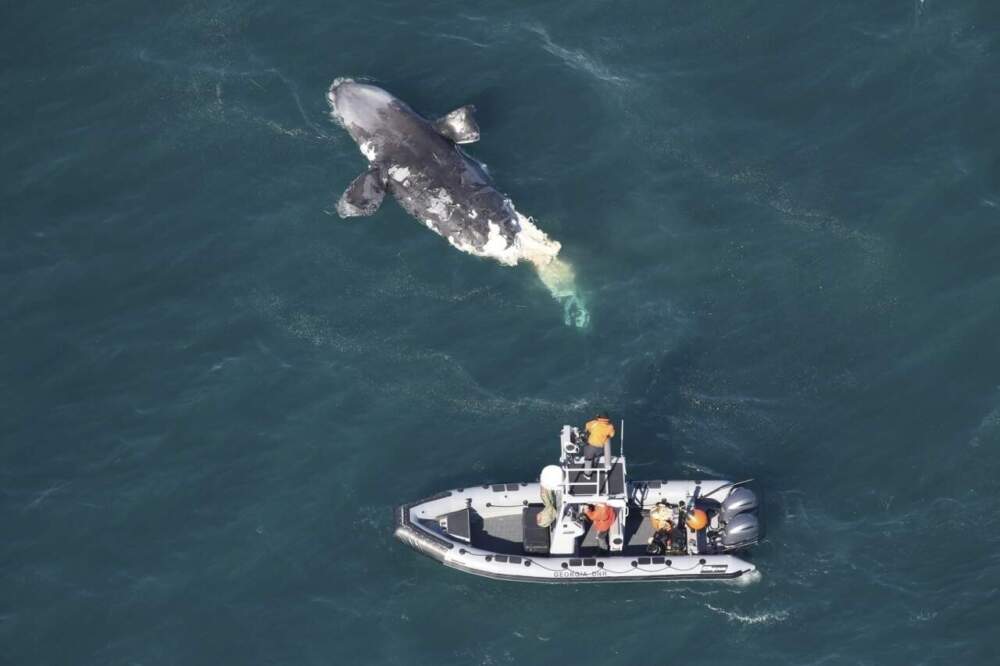
This story was originally published by Grist . Sign up for Grist’s weekly newsletter here .
Amid a difficult year for North Atlantic right whales, a proposed rule to help protect them is one step closer to reality.
Earlier this month, a proposal to expand speed limits for boats — one of the leading causes of death for the endangered whales — took a key step forward: It’s now under review by the White House Office of Information and Regulatory Affairs, the last stage of federal review.
Fewer than 360 of the whales remain; only about 70 of them are females of reproductive age. Every individual whale is considered vital to the species’ survival, but since 2017 right whales have been experiencing what scientists call an “unusual mortality event,” during which 39 whales have died.
Human actions — including climate change — are killing them.
When the cause of a right whale’s death can be determined, it is most often a strike by a boat or entanglement in fishing gear. Three young whales have been found dead this year, two of them with wounds from boat strikes and the third entangled in gear. One of the whales killed by a boat was a calf just a few months old.
Climate change, meanwhile, has disrupted their food supply , driving down right whale birth rates and pushing them into territories without rules in place to protect them.
“Our impacts are so great right now that the risk of extinction is very real,” said Jessica Redfern, associate vice president of ocean conservation at the New England Aquarium. “To be able to save the species, we have to stop our direct human-caused impacts on the population.”
This is not the first time humans have driven North Atlantic right whales to the brink of extinction .
Their name comes from whaling: They were known as the “right” whale to hunt because they spend time relatively close to coastlines, often swimming slowly and near the surface, and they float when dead. They also yielded large amounts of the oil and baleen whalers were after. So humans hunted them to near extinction until it was banned in 1935.
Many of those same characteristics are what make right whales so vulnerable to human-caused dangers today. Because they’re often near the surface in the same waters frequented by fishing boats, harbor pilots, and shipping vessels headed into port, it’s easy for boats to collide with them.
“They’ve been called an urban whale,” said Redfern. “They swim in waters that humans are using; they have high overlap with humans.”
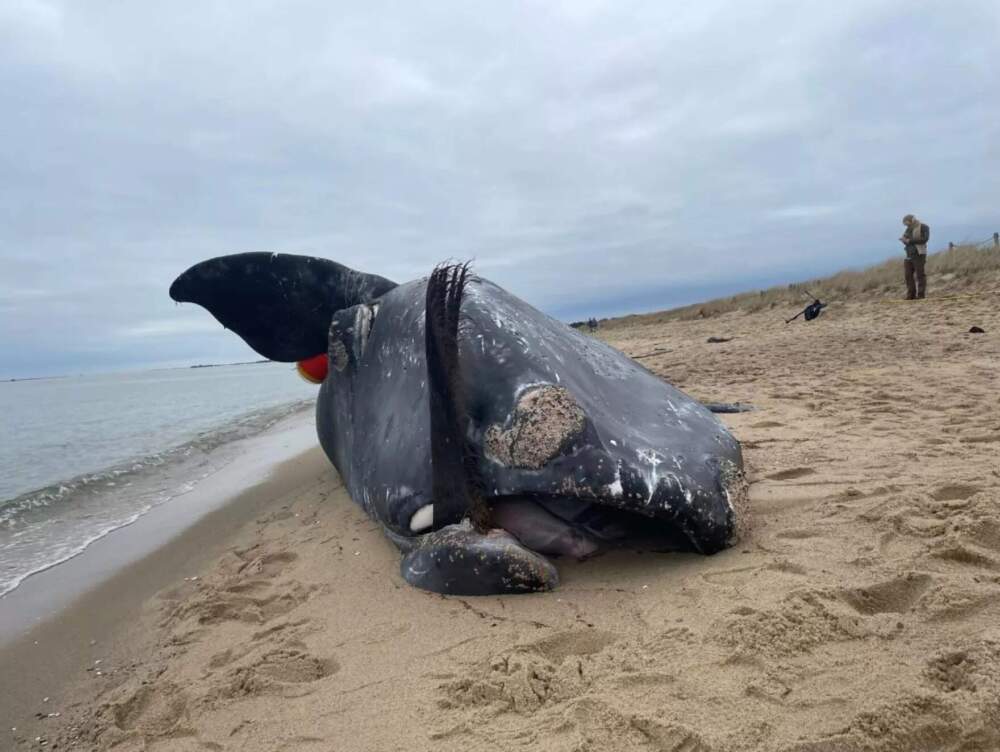
To reduce the risk of vessel strikes, ships over 65 feet long have to slow down during set times of year when the whales are likely to be around. In the southeastern U.S., the speed limits are in force during the winter when the whales are calving; off the New England coast, the restrictions are in place in the spring and summer when they’re feeding. Regulators can also declare voluntary speed restrictions in localized spots if whales are seen, known as dynamic management areas.
The National Oceanic and Atmospheric Administration, or NOAA, in 2022 proposed expanding those restrictions in three ways.
First, the new rule would cover larger geographical areas. The protection zones would extend down the coast from Massachusetts to Florida at various times of year, instead of only applying in certain distinct areas.
Second, the change would apply the speed limits to smaller craft like fishing boats, rather than only ships over 65 feet.
Third, the new rule would make the speed restrictions — the temporary speed limits where whales have been spotted — in dynamic management areas mandatory.
Since NOAA published and gathered feedback on the proposed rule in 2022, whale advocates have been clamoring for the agency to implement it. Those calls have increased in recent months as dead right whales have washed up on beaches.
“There have been three deaths, and that has been really devastating this year, and two of them are related to vessel strikes,” said Redfern. “It’s just highlighted that absolute urgency, the necessity of getting this rule out.”
A leading boating industry group is speaking out against the expanded speed restrictions, arguing they could hurt small businesses in the recreational boating industry.
“We are extremely disappointed and alarmed to see this economically catastrophic and deeply flawed rule proceed to these final stages,” said Frank Hugelmeyer, president and CEO of the National Marine Manufacturers Association, in a statement. “The proposed rule is based on incorrect assumptions and questionable data, and fails to distinguish between large, ocean-crossing vessels and small recreational boats.”
Right whale scientists have documented in recent years that small, recreational boats can injure and kill right whales. At least four of the lethal vessel strikes since the current restrictions began in 2008 have involved boats smaller than 65 feet and thus not subject to that speed limit, according to Redfern.
NOAA estimated that, based on the size and placement of the propeller wounds, the boat that killed the months-old calf this year was between 35 and 57 feet in length — too small to fall under the existing speed restrictions, but subject to the new rule if it were to be implemented.
In his statement, Hugelmeyer also pointed to new marine technologies aimed at detecting right whales in the water to reduce vessel strikes without expanding the speed rules.
Scientists like Redfern remain skeptical, though.
The tech “offers a lot of promise,” she said, but the speed limits are proven.
“It’s really important, I think, that we rigorously evaluate the technology that’s proposed to make sure that it is going to achieve the same type of risk reduction that we see with the slowdowns in expanded areas,” she said.
Many groups, meanwhile, have raised concerns that offshore wind turbines could harm whales. There is no evidence of that, according to NOAA.
This article originally appeared in Grist , a nonprofit, independent media organization dedicated to telling stories of climate solutions and a just future. Learn more at Grist.org
More from WBUR

IMAGES
VIDEO
COMMENTS
Hydrofoiling wingsail catamaran 17. A sailing hydrofoil, hydrofoil sailboat, or hydrosail is a sailboat with wing-like foils mounted under the hull.As the craft increases its speed the hydrofoils lift the hull up and out of the water, greatly reducing wetted area, resulting in decreased drag and increased speed. A sailing hydrofoil can achieve speeds exceeding double and in some cases triple ...
Hydrofoil racing yachts can achieve impressive speeds, with some models reaching over 50 knots (57.5 mph or 92.6 km/h). The F50 sailboat class, used in the SailGP series, holds the record for the fastest sailboat class, with a top speed of 52.2 knots (60 mph or 97 km/h).
Despite several years of foiling behind us now, most of the world's sailing records are still held by non-foiling boats. But if foiling boats are so much fas...
The first issue is how much foil surface area you need to lift the boat. This varies with speed: the faster you go, the less you need. Early foil design used ladder-type racks of foils which ...
How SailGP's foiling F50 catamarans sail so much faster than the wind. Jonathan Turner. January 8, 2023. Arguably the most technologically advanced sailboats on the planet right now, the one-design SailGP F50 foiling catamarans are capable of breathtaking speeds - at times, reaching four times the velocity of the wind that drives them.
Short answer: Foil sailboat A foil sailboat is a type of sailing vessel equipped with hydrofoils, which are wing-like structures submerged below the water's surface. These foils generate lift as the boat gains speed, enabling it to rise above the water and reduce drag, resulting in increased speed and efficiency.
With razor-sharp hydrofoil catamarans that help them hit speeds of 60 miles an hour, the athletes of SailGP are pushing the limits of physics and human endur...
The foil provided some eight to 10 tons of vertical lift for Wild Oats XI, significantly improving the boat's righting moment as its speed built; in short, it kept the boat's bow up under spinnaker and made for longer and more controllable surfs in the heavy airs of the Bass Strait.
The Swiss-based SP80 speed project aims to reach 80 knots with a kite pulling its surface-skimming trimaran. A subsurface superventilating foil counters the lift of the kite, and a mechanical ...
Hydrofoil sailboats blend speed, stability, and innovation for a fun sailing experience. Their design lifts the hull above water, reducing drag and enabling high-speed travel. Advanced control mechanisms maintain stability in varying wind conditions. Sails and hulls are meticulously engineered for optimal aerodynamics and lift.
There's a revolution underway in the sport of sailing, and it can be summed up in one simple word: foiling. More specifically, we're talking about hydrofoils, the winglike appendages mounted beneath the hull of a vessel that, at a certain speed, lift the hull clear of the water. When this happens, the foiling sailboats can reach speeds two ...
The history of foiling. The early development of hydrofoils started over 100 years ago when Italian Enrico Forlanini achieved 36.9 knots with his 60hp airscrew-driven boat in 1906. Several ...
In this video we talk about how Sailrocket 2 works, including how it smashed through the 50 knot foil cavitation barrier to break the sailing speed record at...
The current world sailing speed record has stood for a little over a decade at 65.37 knots (75.23 mph/121.06 km/h), set by Paul Larsen in the Vestas Sailrocket II back in 2012. There's a reason ...
Foiling technology can be traced back to 1898 when Italian inventor Enrico Forlanini began work on a 'ladder' foil system, obtaining patents in both the UK and the USA. He had a prototype operating on Lake Maggiore soon after. British boat designer John Thornycroft followed up with a series of scale models featuring stepped hulls and a ...
DESIGN PARAMETER: Hydrofoil (It is a foil or wing under water used to lift the boat s hull until it is totally outside the water.) 1. At low speeds the hull (body of ship) sits in the water and the hydrofoils are totally submerged in the water. 2. As the boat s speed increases, the hydrofoils create lift.
A little over a week earlier, at a spot called Walvis Bay on the coast of Namibia, Sailrocket 2 had pushed the outright sailing speed record up by the biggest-ever margin - from 55.65 to 59.23 ...
The future is now for Alex Thomson aboard the soaring IMOCA 60 Hugo Boss. Courtesy Alex Thomson Racing . By the 1980s, numerous speed-trial and foil-enhanced offshore-racing multihulls showed huge promise, and have since evolved into behemoth trimarans clocking 30 to 40 knots continuously for long periods, not to mention the monohulls in the Vendée Globe (and soon the Ocean Race) that are ...
Did you know that the French startup Syroco lab is working on the fastest sailboat of all time. It should happen in 2022: a wind-powered boat has to break the speed barrier of 150 kilometers per hour. We explain how the team led by Alex Caizergues, 4 times champion kite speed, with a six-meter-long fish-shaped capsule that is pulled by a kite ...
Hydroptere : fastest sailing boat in the world with a speed record of 51.36 knots. An incredible hydrofoil !
The flight control system, combined with numerous fine-tuned innovations, ensures safe foiling even in strong winds and rough seas.. Stable flight attitude allows pushing hard, so in good conditions, iFLY reaches high boat speed beyond 30 knots in a controllable way. IFLY15 offers freedom to fly alone or in pairs.
BOAT SPEEDS FAR BEYOND DOUBLE WIND SPEED CAN BE ACHIEVED. Enjoy high speed foiling with top speeds far beyond 25 knots - in ideal conditions up to 30 knots. ... . #ifly15 #sailing #foil #iFLY #foiling #sailboat #catamaran The quality and performance has been proven for 7 years and further developed to maximum perfection in every detail. . # ...
Doing nothing is very easy! Putting a boat together is worthwhile but obviously involves effort. The current cartop to launched speed record is roughly 15 minutes. Socket the mast together. Attach the boom and stays in one go. Step the rig. Flip the boat on its side, insert the foils, right the boat, hoist the sail and launch. Complexity is ...
The wing foil, wrote Australian Sailing in November, is "fast becoming one of the most sought-after water sports across the globe and has started to make inroads on the racing scene".
This photo provided by the Georgia Department of Natural Resources shows a DNR boat crew assessing a dead juvenile right whale about 20 miles off Tybee Island, Ga., Wednesday, Feb. 14, 2024.